#revises chrome
Text

On top of the falls.
Where wolves seem small.
And where a rabbit can feel tall.
At least briefly.
Redraw scene with Poppy and Chrome.
Really love how this revision turned out with the more definition of trees and everything.
2017 version

172 notes
·
View notes
Text
🎧A Guide to the TGCF Audio Drama🎭
With the release of the new season of the fabulous TGCF audio drama, I wanted to make an updated guide on how to make an account, purchase, and listen (with English subs) to it! Hopefully, this will help more people enjoy it and join in on the fun!
As a quick reminder, the audio drama is based on the revised version of the novel! It's a very faithful adaptation, but if you're a new fan, that might throw you for a loop! If you need an overview of the different versions of TGCF, check out this post first!
Part One: Making an Account & Purchasing
The process is a lot easier than you may expect! The site where the audio drama is hosted is "missevan.com," also known as "MaoerFM." They are one and the same!
Check out these infographics to create an account and buy the audio drama. (Due to tumblr compression, they may be difficult to read. If this is the case, please view these images in full-screen and preferably on a web browser for best quality!)




ADDITIONAL INFORMATION
General Info:
It costs 319 diamonds for the first season, and 359 diamonds for the second season of the TGCF audio drama. This was less than $5 USD, for each season. Future seasons will likely be similarly priced.
Episodes typically release weekly. Mini-episodes/bonus content releases intermittently, and often continues after the main season "ends."
This guide will work for any other audio dramas you want to purchase and support (such as MDZS)! They obviously have different costs, but the process of buying is pretty much the same.
Account/Registration Info:
If you do not see your country/region code listed when making an account, it is unfortunately unavailable there. I do not know any workarounds at the moment, apart from asking a friend/relative in a different country to help you out! If anyone does know other options, please let me know!
Step One of the guide is technically optional, as logging in on the app for the first time will automatically create a new account, if there’s not already one associated with your mobile phone number. I recommend doing that step anyway, as it will ensure that you have a password linked to your account. Several people in the past have reported that they sometimes cannot receive the verification code to log in. (Especially from South America and SEA for some reason.) Having a password bypasses this, if it happens to you.
Unfortunately, it seems that you MUST register with a mobile number to begin with.
Otherwise, you can use an existing Bilibili/QQ/WeChat/Weibo account if you have it. They all require a number for registration too, as far as I know, so you may run into the same problem. They may still be worth trying if you have no other options! Once again, if anyone is aware of other workarounds, do let me know.
Additionally, it’s possible to link your account to an email AFTER you register with a mobile number. (There’s no escaping that, from what I can tell.) You can then use that to log in.
It seems useful to have your email and a password associated with your account, especially in case your country code gets nixed from availability -- which has been known to happen without warning in the past.
The mobile browser seems to prefer you log in with a number/email and a password, rather than a verification code.
LINKING AN E-MAIL TO YOUR ACCOUNT (Optional)
This must be done via web browser, or with your mobile browser set to desktop mode. It’s VERY easy if you use a browser with an auto-translate feature like Google Chrome:
(These images are the MTL translated versions!)

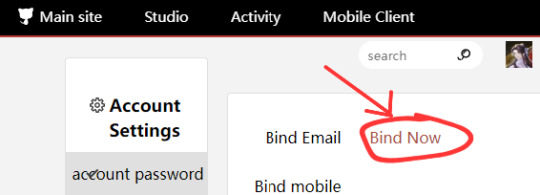


Unfortunately yes, you will need to receive a verification code via mobile number to enable this. The second verification code gets sent to your email, though! (Try not to lose your password, because I'm pretty sure you'll still have to use your phone to verify and change it.) Don't forget to check your spam folder if you don't see it. It will be from "猫耳FM."
Once again, this is optional! I just wanted to include it as an extra avenue for people who may struggle with the verification codes, as they can be finicky. And it happened to me while I was making this section, so I knew I had to....
Part Two: How to Enable English Subtitles
First things first: there are no official English subs for the TGCF Audio Drama. Though I'm fairly sure this applies to all dramas on MaoerFM.
However, there are Chinese (Simplified) subs for each episode.
OPTION ONE: MTL
The main method that non-Chinese speakers have been using to understand the Audio Drama is via MTL (machine translation) on those subs! Browsers like Google Chrome not only have auto-translate, but it works in real time as you watch/listen to the episode.
Make sure that it's turned on and that you've selected English -- or your preferred output language!
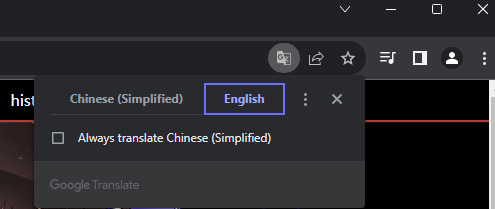
Be aware there are TWO types of subtitles on MaoerFM. There are the official subs, and the temporary subs.
At the bottom of the audio player, there is a button labelled "字幕," which is circled in purple in the image below. If it is there, it means that episode has official subs available, and you can toggle them on/off. Meanwhile, the "弹" that the green arrow is pointing to is known as the "barrage." That's the scrolling text that you will see filling the screen. It's other fans screaming and crying in chat. You can turn it off if it feels overwhelming!

New episodes may take anywhere from a few hours to a day or two to be officially subtitled. (The bonus episodes don't have official subs for whatever reason.) In the meantime, there will be subtitlers working on adding temporary subs! I'd advise waiting a little while before listening to a new episode so they have more time to work, and you'll have better coverage!
While official subs are entirely separate, the temporary subs are part of the barrage. So you will have to keep the barrage turned on. (Notice how there is no "字幕" button next to it yet!) Unlike the rest of the barrage, the subs will be stationary, color-coded, and at the very bottom of the window -- so they're easy to differentiate.

However, since the barrage can be a lot if you aren't used to it, there is a way around it.
Hit the settings menu (blue circle) and block the scrolling comments. You can also turn off the top ones, but just make sure not to turn off the bottom ones -- because those are the subs!

DO NOTE that this all works best on desktop! If everything's gone correctly, you should have something like these:
Right -- regular view, temporary subs
Left -- full-screen, official subs


It's possible to get this to work on mobile if you enable desktop mode in your Chrome app. You will probably need to refresh a few times after that, or open the page in a new tab to have it work properly. Then it's the same steps as above!
You should have something like these:
Right -- landscape mode
Left -- portrait mode


The scaling on mobile can be troublesome, and I have noticed that the auto-translate is slower than on desktop. It seems to take an extra second or two to work on each line -- whereas on desktop it's pretty instant -- and that can get annoying, especially in fast-paced scenes.
Additional Info:
This does not work for the mobile app! It is for the website ONLY!
If the translation stops working, refreshing usually fixes it.
There are potentially other options to using Chrome. Any browser that has an auto-translate will work, assuming it's as quick as Chrome's. If anyone has tried other browsers and seen success, please leave a reply!
OPTION TWO: FANSUBS
TreasureChestSubs here on tumblr have been doing high-quality fansubs for several audio dramas, including TGCF as of recently! However, at the time of making this guide, their TGCF translations currently only cover the first few episodes of season one. You will need to request an invite to their Discord server via the form in their posts. Please do check them out if you're interested.
I don't personally know of any other fansubbers who are actively working on the audio drama right now. But I do want to mention that Xyra_Rei on twitter has a Discord server where they share some translated snippets from various episodes. There are other great resources by fellow fans, too. Links and more info about the server can be found in the pinned post on their profile!
Part Three: Enjoy!!!
I hope this updated guide helps more people experience the wonder that is the TGCF audio drama (or really, any audio drama)! I cannot overstate how good it is in every aspect, and I think every TGCF fan deserves to be able to hear it for themselves! 💖
#tgcf#tian guan ci fu#hob#heaven official's blessing#tgcf audio drama#guide#nyerus.txt#yes fellas this is my only use-case for chrome and tbh... lmk of other options please lol#anyway the TGCF AD has my entire heart and soul PLEASE LISTEN TO IT
100 notes
·
View notes
Text
when robots got muscles
You can blame @centrally-unplanned for this post. She(?) wrote...
The ‘chrome’ designs pioneered by illustrators like Hajime Sorayama (Sexy Robot from 1984, for example) tended to be more in vogue at this time (or just…a hot girl, who is apparently a robot, trust me bro), you don’t see designs like this too commonly until later (ask resident robo-fetishist/animator expert @canmom for details on that timeline).
After a challenge like that how can I refuse? Although the question is ‘when did robots get muscles’, this turned into something of a historical survey of robot designs from the 80s on with a throughline of biomimesis.
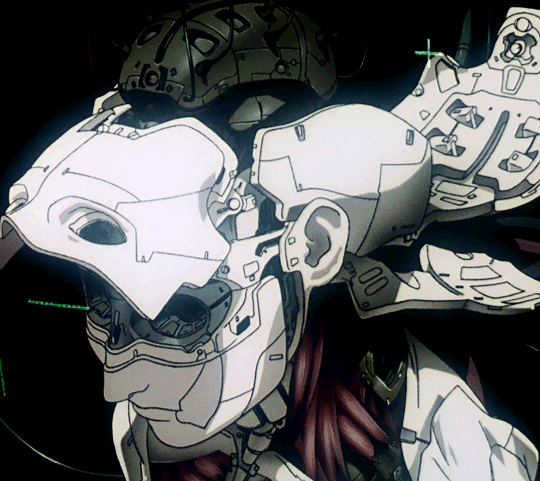
(Originally this was just going to be an excuse to talk about Ghost in the Shell... but I gotta be thorough.)
This was all brought on from this picture from a 1989 fanart magazine...
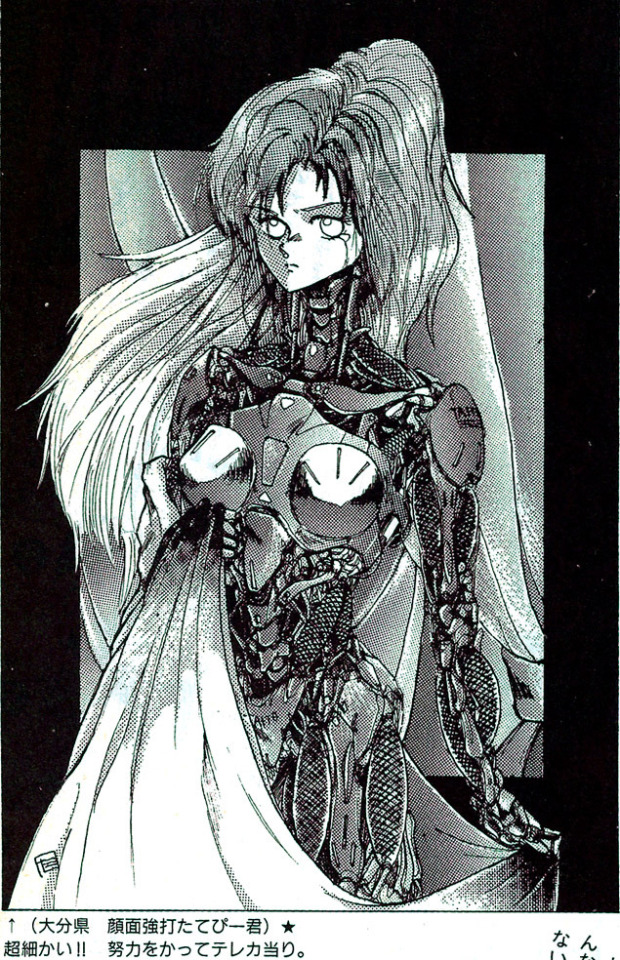
by an artist going by ‘Facepunch Tatebi-kun’ (顔面強打たてびー君, Ganmenkyouda Tatebii-kun). I remarked that it was interesting to see these kinds of ‘robot muscles’ in a picture from 1989, since I thought that kind of design became popular in the 2000s.
On some reflection, I think I gotta revise that opinion! I think ‘robot muscles’ became a thing around the mid 90s in anime; in the West I think it took a bit longer. But you can also see precursors already before that.
So. One thing artists are super into is biomimetic robots. That is, robots whose form (and perhaps function) is similar to animals, especially humans. The word ‘android’ referring to a human-like automaton dates all the way back to the late 19th century, but the modern ‘android, robot, cyborg’ taxonomy apparently became established around the 40s.
There’s two types of humanoid robot that get a lot of play, especially in anime. One is the convincingly humanlike cyborg, which is the same size and shape as a normal human; the other is a what we call in English a ‘mech’, i.e. a big robot you can sit inside.
Of course, if your androids just act like humans all the time, then there’s not much point having them be robots. To really create the frisson of contrast between human and mechanical forms you have to show the mechanism somehow. This could be because the machine isn’t perfectly human-like, and has visibly mechanical joints - take a look at the works of @sukabu89 for very inventive depiction of this theme - or, the android could be damaged or undergo maintenance.
When you attempt to translate biological forms into a more mechanical design language, the traditional way has been to use hard, rigid shapes, since these make the contrast especially clear. In more recent designs, particularly as we started to see real robots with ‘artificial muscles’ such as the ones created by Boston Dynamics, we get another sort of design language to express ‘mechanical parts’, and robots start having more biological forms with exposed plasticy muscles.
So let’s tell the story. We begin at the end of the 70s.
the dawn of mechaguro
For an early example of ‘mechaguro’ (a term I’m applying very anachronistically!), when a robot gets smashed up, we have Alien (1979). This film did a ridiculous amount to define sci-fi design language, and of course the alien itself blends mechanical and biological forms, with its glossy black surface allowing it to seem to melt into the exposed pipes of the spaceship. But let’s focus on the character Ash, a secret android who is broken apart in the second half of the film.

When Ash is torn apart by the alien, his insides consist of weird white plastic beads and a milky fluid that seems analogous to blood. It’s not clear what the function of any of this tech is - it’s intended to be vague and mysterious. The outside is biomimetic but the inside is anything but. He has a kind of artificial skin which resembles a latex mask.
The Terminator films are another major touchpoint for 80s science fiction. Late in the film, Arnie starts taking damage which reveals the Terminator skeleton underneath his fake skin.


The stop-motion Terminator model is basically designed according to the principle of ‘replace human bones and muscles with hard metal bits’. So you have a metal skull, metal clavicles (which are pistons for some reason), metal shoulder blades, hydraulic pistons generally in the places where muscles are. e.g. in the above picture you can see pistons that stand in place of the sternocleidomastoid muscle, and in this picture...

...you can see metal scapulae and piston biceps and triceps and a piston. The shoulder joint by contrast built in a very non-human-like way. Also there’s random tubes everywhere lol.
That’s generally how androids are portrayed in the 80s. The ‘droids’ in Star Wars are similar; C-3PO is an arrangement of metal plates with gaps suggestive of underlying mechanical details and rudimentary joints and pistons.
In Blade Runner, we have the Replicants, humanoid robots - but by the premise of the film, they are essentially indistinguishable from humans. So when the Replicants die, we never really get to see their robo-innards.
and now, anime
OK, that’s the big four Western 80s sci-fi movie series; what of anime? Of course, androids in anime go all the way back to Astro Boy. But most of these early designs don’t really focus on mechanical details all that much. Super robot designs are more like tokusatsu suits than anything. There were certainly instances of impressive mechanical animation in the 70s, with early experts including Kazuhide Tomonaga on Space Battleship Yamato. Then there’s Hayao Miyazaki’s episodes of Lupin III Part 2 which featured proto-Nausicaa flying a prototype of the robots from Castle in the Sky. It would be some years before anyone could come close to matching these!
The original Gundam in ‘79 famously started the ‘real robot’ movement [Animation Night, so let’s take a brief look at how a Gundam fits together.
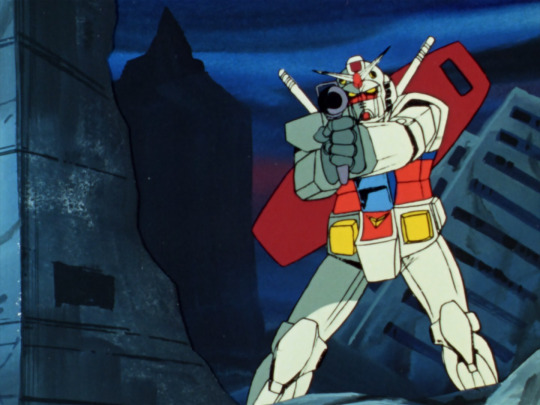
Generally speaking, the way Gundams are drawn in Gundam ‘79 is kind of rough. The methods to animate these rigid mechanical systems in super accurate perspective were just not yet established at the end of the 70s, certainly not on a TV budget. The actual joints on the Gundam are left very vague, but it broadly speaking seems to move like a human in armour.
But the OVA boom was about to begin, and while it would be a while before we saw the heights of Headgear/Production I.G./Gainax, things were going to change a lot. Mechanical design and animation was about to get much more sophisticated very very quickly.
In 1982, we have Super Dimension Fortress Macross, with robots that transformed into fighter jets. Its robots are designed by Kazutaka Miyatake, who cut his teeth doing mechanical design for Space Battleship Yamato and Daicon. The Macross TV series introduced the world to the animation of Ichirō ‘Missile Circus’ Itano. [AN64] A plane with legs... honestly looks kind of goofy, but Itano’s ambition to have a highly mobile 3D camera that could move in ways that would simply be impossible in live action marked a huge step up in how robots are animated. And this would get refined even further in the film Do You Remember Love.
In terms of design, we’re really moving our inspiration from ‘tokusatsu suit’ to ‘military hardware’ here. A Macross suit has to look like something that could transform into a plane, so its silly little arms and legs have to look kind of plane-like. In any case, we are definitely still in a world of hard and rigid robotics.
Dallos (1983-4) dir. Mamoru Oshii is known as the first OVA, if not the first successful OVA [AN115]. It features a variety of mining robots on the surface of the Moon, which are generally less humanoid, taking their design cues from JCBs...

...as well as humanoid robots with fairly clear joint patterns...

...and more humanoid robots too.
The eponymous Dallos, however, is a huge humanoid robot that looks like this...

Here we have a pile of mechanical shapes that vaguely calls to mind a human face. It’s suggestive of motifs we’d see later in works like Akira.
A year later in 1985, Megazone 23 really kicks off the OVA boom in earnest [AN 103]. It also has a robot, in the form of a transforming bike that can become a humanoid piloted mech...
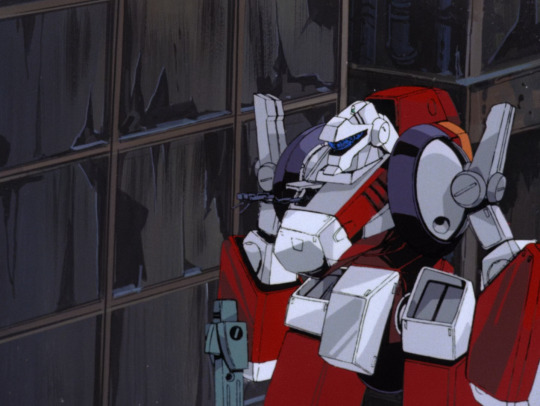
You can see mechanical designs and shading have become considerably more detailed; its motion is a lot more complex as well with a ton of indulgent background animation shots. The actual details of the bike -> robot transformation are rather brushed over. But to sort of sum up the design language: we have organic but hard-edged shapes contrasted by inorganic but round shapes. (These terms ‘organic’ and ‘inorganic’ refer mostly to symmetry and a sense of ‘flow’ in the shape.) There are few right angles as such, but a lot of broadly boxy topology. The shapes are broken up by elaborate specular highlights in complex shapes, a motif of the later Kanada school.
OK, but that’s all variants on ‘rigid robot’ so far - what about the androids? What about the more directly biological designs?
Following the enormous success of Megazone 23 Part I, Toshiki Hirano got the chance to adapt his favourite lesbian cosmic horror hentai manga Fight! Iczer One into a rather more tame OVA which released from 1985-87. In terms of mechanical design, this starts to do some interesting moves towards blending biological and mechanical forms...
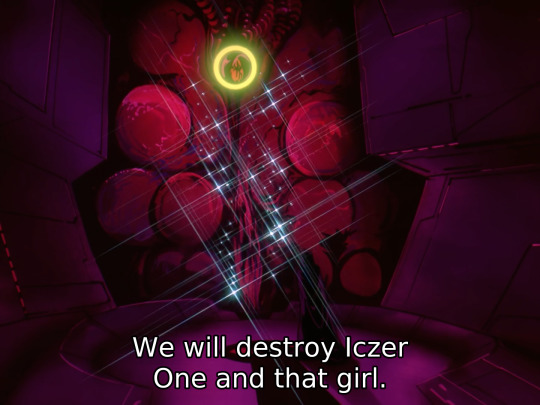
Of course it has a robot in addition to the requisite bishōjo and lightsabers. In contrast to the boxy shapes we’ve seen so far, the robots in Iczer-One have a much more curvy organic sort of design language. Still, there is not a lot of emphasis on the precise details of mechanical articulation outside of select shots. (It is however notable for the first ever Obari punch!)
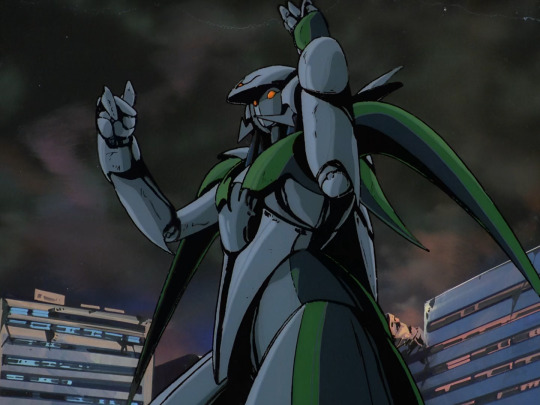
Despite the change in shape language, these are still very clearly animated as metal plates and not yet muscles.
In 1984 we have a very important film (for this narrative, and in general), Nausicaa of the Valley of the Wind, the film that created Studio Ghibli. Here we have the ‘God Warriors’, giant humanoid weapons with the ability to shoot a massive laser out of their mouth. Rather than robots, these are very much biological in nature, having to be grown in a kind of cocoon. In the film version of Nausicaa, an incomplete God Warrior is released, leading to an iconic scene animated by Hideaki Anno in which the God Warrior attempts to blow up the oncoming wave of Ohmu.

The God Warrior’s melting flesh is gorgeously animated, bubbling and sloughing off in great big lumps as the skeleton pokes out from underneath. Throughout, Nausicaa is full of beautiful and impressive animation of both machines (mainly planes) and biological (the giant insects), but the God Warriors, as human-made lifeforms, bring the two together. However, this strand wouldn’t be especially followed up on for a long long time.
Right, but what about Bubblebum Crisis (1987-91)? That is, after all, the iconic 80s robot girl OVA. It’s inspired heavily by Western robot-related films like Terminator and Blade Runner; here we have ‘Boomers’ (never stops being funny) as androids that can appear convincingly human. Like the Terminator, the underlying metal parts can burst out. Here we have a metal frame designed to resemble muscles, and also metal tentacles.
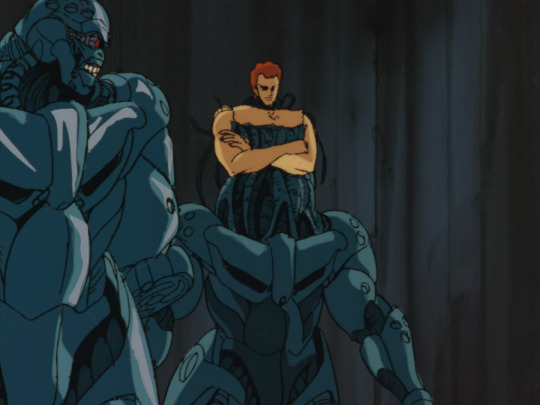
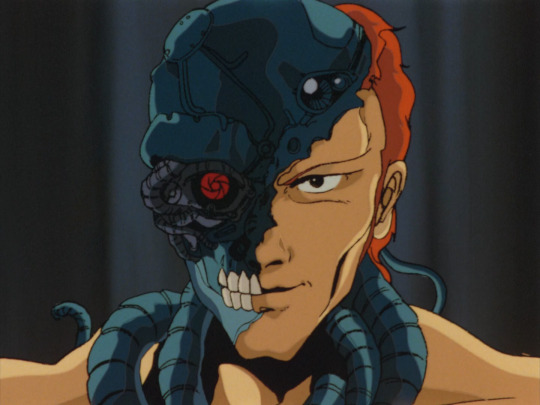
The shapes of these robots are a lot more organic. The robot neck has tubes that sort of resemble the neck muscles, metal plates that resemble pectorals and abs and deltoids and biceps and so on. You’ve even got a direct riff on the Terminator ‘fleshy face falling away to reveal metal skull with glowing red eye’! Under the plates there are clusters of tubes which also heavily resemble muscles. Also you’ve got the classic ‘three small circles’ motif there.
Contrasted against them are the Knight Sabers, who aren’t cyborgs as such but fight in powered exoskeletons which fit the design motifs of robot girls.
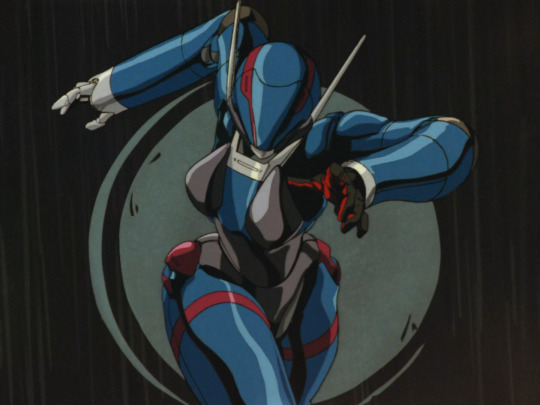
These suits are quite form-fitting, with a rubber under-layer and metal shells on top. There is definitely some attention paid to how they’ll articulate around the joints. One very recognisable 80s motif is the sort of extending spike thingies you can see on her hat there; there’s also the jets that extend out behind the suit. And, you have that multi-layer shiny highlighting of course!
Still, the way the characters move in Bubblegum Crisis is still very squarely Kanada School poses; big movements, lots of held poses accentuated by flashing and line boil, not a lot of concern for conservation of momentum or anything like that.
For a contrasting strand we can look at the rise of the ‘Otomo school’ (if you will) of realism. Around the end of the 80s, a pool of talented animators were gathering around Katsuhiro Otomo. Their most famous work is Akira, but I’m actually going to begin with Robot Carnival (1987), a wonderful anthology of short films from 1987. This features a huge variety of interpretations of the concept of robots.
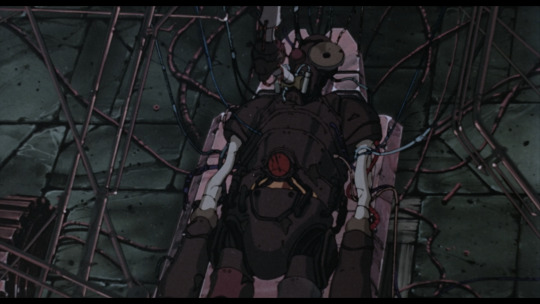
For example, for Kōji Morimoto, later co-founder of Studio 4°C, the robot is a kind of cobbled-together steampunk Frankenstein’s monster. It’s a very cool design with all sorts of asymmetries and exposed parts suggesting its cobbled-together nature. And although all the robot does in this short is stand up and then fall over, a great deal of attention is paid to the little details of its articulation and its movement through space.
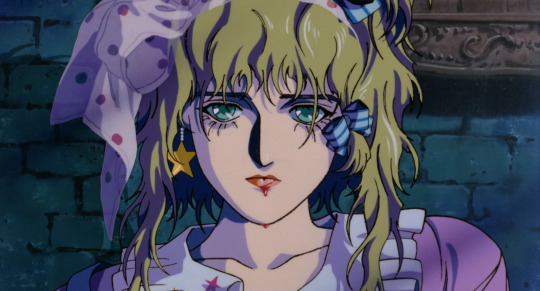
Presence, directed by Yasuomi Umetsu, is notable for its steps in the direction of realism - Umetsu’s characters are hyperdetailed and in some ways over-drawn. The opening shots establish this is a world where lifelike androids are common, when an android gets his head kicked off and stolen by children. Here the robot-as-doll metaphor comes in, something that will be increasingly central in the next decade. The robot girl is essentially a human-sized doll in a room full of other toys. Her creator smashes her to pieces with a wrench; later her ghost visits him as an old man. We see the girl attached to a bunch of wires, but she bleeds like a human.

Cloud by Manabu Ōhashi features another humanoid robot, an Astro Boy-like child recognisable as a robot based on his segmented torso and legs and robotic ear... cones. Here the robot is a standin for human emotions, the boy’s struggles projected onto the constantly changing sky as he walks against the wind.
Strange Tales of Meiji Machine Culture: Westerner’s Invasion by Hiroyuki Kitakubo (later to direct Golden Boy, Roujin Z and Blood: The Last Vampire) is a sendup of mecha shows in which two very goofy looking steampunk robots operated respectively by Japanese and Western crews duke it out, laying waste to the city around them. The Japanese robot is basically a big wooden samurai...
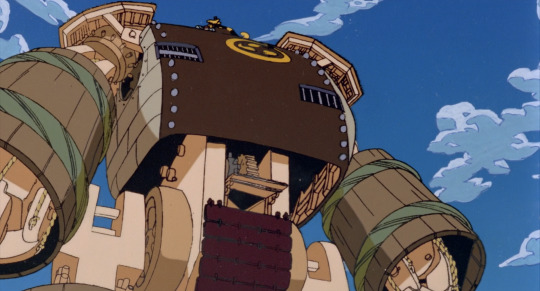
and the Western (more specifically American) robot is, uh
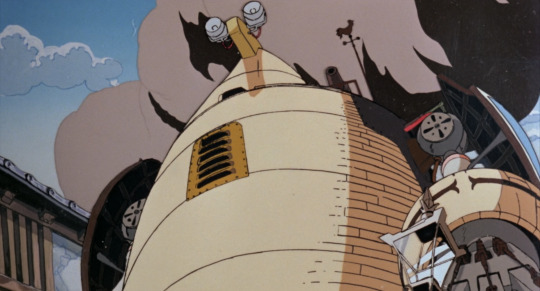
sorta big barrel with little eyes on top? I’m not entirely sure what the deal is with this design!
That’s really not relevant to our story tbh I just think it’s a neat short.
Chicken Man and Red Neck, by Takashi Nakamura, features especially distinctive robot designs. The film is kind of a dream sequence in which a terrified drunk man witnesses the revels of the machines of Tokyo, transformed into robots; the robots are extremely shaped, moving through a world that is pretty much just pistons...
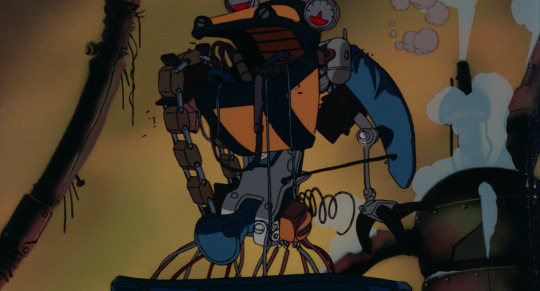
These robots call to mind the dancing demons in Fantasia’s Night On Bald Mountain sequence, or even Bosch.

Otomo’s own segments feature the Robot Carnival itself, a vast mechanical structure built as... well some kind of entertaining spectacle, but which now drives around the post-apocalyptic wasteland dropping robots which explode as bombs. It’s cute.
OK, to wrap up the 80s, we gotta cover Akira (1988) [AN34]! Akira has plenty of impressive mechanical animation of helicopters, hovercraft thingies, satellite lasers and of course the famous bike, but it doesn’t really feature robots as such - but what it does have is a blending of mechanical and biological forms in its climactic sequence where Tetsuo’s psychic powers go out of control. First, wires start to spread like the roots of a plant from his robot arm - less an actual machine and more something he assembled with his psychic powers...
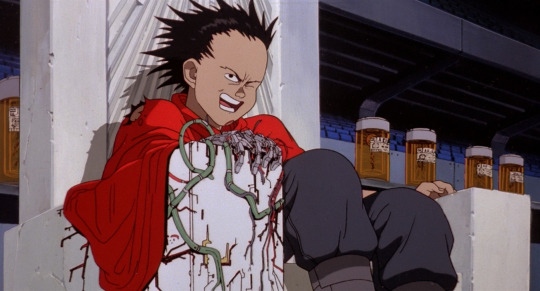
He takes a bullet, and the mechanical wires and muscles start to blend together and spread out like a slime mold...

...which he can extend as essentially a giant tentacle.
When his powers fully go off the rails, he bulges out into big blobs of flesh which have both veins and wires running over them. These burst out of the metallic parts as well.
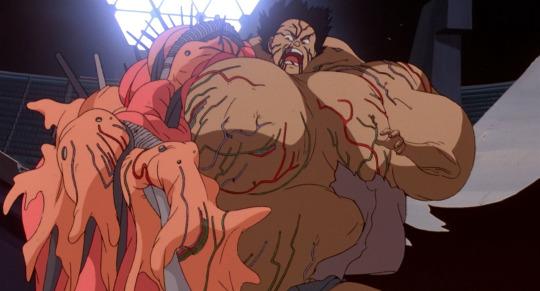
He turns into essentially a giant biomechanical baby.
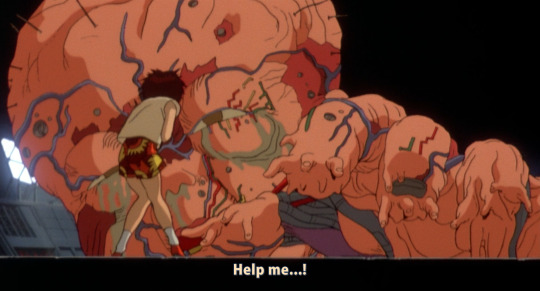
Did Akira invent these images of blending biology and machinery? Probably not, but I’m not really familiar enough with manga of the time to say. What can at least be said is that Otomo’s absurdly meticulous style could really sell it. Otomo was truly a god of perspective and detail; Akira the film was an enormous, prestigious production that threw ludicrous effort and resources towards realising his vision (which doesn’t mean it paid its inbetweeners much more...). A lot of the animators who worked on Akira would go on to be prominent in...
the 1990s
So, the 1990s. If the 80s was dominated by the later Kanada School, the new movement of the 90s, at least as far as film animation goes, was ‘realism’.
But before we get onto that, let’s take a brief look at Gunnm (1990). Known as Battle Angel Alita in the West, this manga by Yukito Kishiro depicts a world in which most people are cyborgs; it was adapted to an OVA by Madhouse in 1993 and became wildly popular overseas. Its protagonist Gally, aka Alita, starts out the story as a wrecked cyborg body like this...
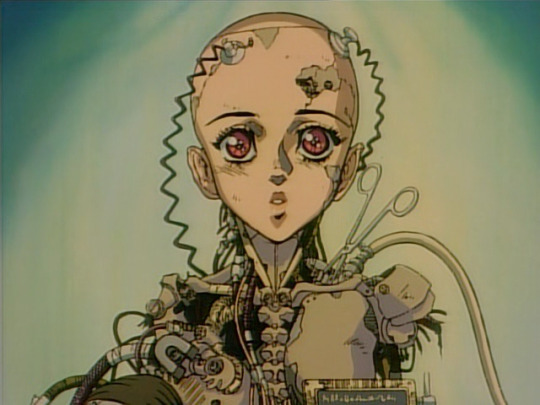
Looking at this design, you can see similar patterns as we have so far. We have metal clavicles, metal sternocleidomastoid muscle, metal pectorals, metal spine. There aren’t robot muscles, per se, but there’s a lot of attention to detail on mimicking biological shapes.
Before long she is rebuilt (twice in the manga, once in the anime). Her new body is like this...

...which is to say a skintight bodysuit in the middle, and metal arms. These arms, although designed in a way that indicates hard surface and with a hinge joint at the elbow, are designed in a way that mimics the flow of muscles in a human arm. By contrast, her sorta-love interest Yugo has a body like this:

which gets mashed to pieces in the finale of the OVA. There’s a striking mechaguro scene in which Gally catches Yugo, but leaves him hanging by a fraying arm, which snaps, leaving him to fall to his death. Compared to later iterations of the ‘robot arm torn apart’ device, this one’s relatively light on detail...
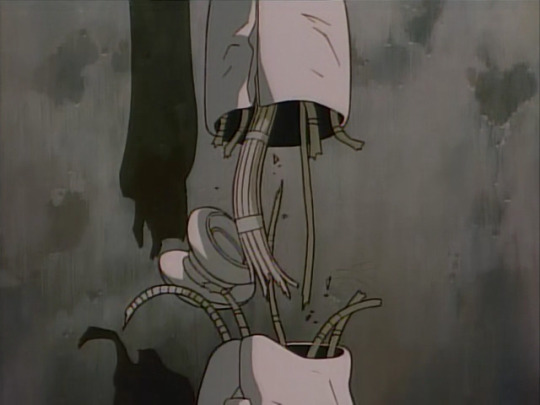
Cyborg bodies in Gunnm are used as a visual indication of character type. Gally has curves but also sleek robo muscles: she’s a Beautiful Fighting Girl, sweet but also extremely powerful. A huge ‘muscular’ cyborg with wide shoulders is likely to be a brute. Yugo here has much more plain, simple shapes with visible bolts, not precision pieces like Gally.
I don’t know how much of this originates with Gunnm. I’m sure the idea of cyborg girls was in the air long before, but this became an influential example on the tail end of the time of the 80s bishōjo. One device that is notable here is the idea of a ‘full body cyborg’, which is only human down to the brain (or perhaps not even that). Body swapping is a major theme in Gunnm, something that would be expanded on before long...
And if that was going out, what was coming in? Let’s look at Patlabor, which traces the evolution of the Headgear artistic collective and IG Tatsunoko into Production I.G.. This is about as down to earth as giant robot stories can get, with robots as just everyday machines used for work and by the cops. But where things really go nuts in animation terms is the opening to Patlabor 2 (1993).
youtube
Here you can see some of the most impressive sequences of mechanical animation ever drawn. We see pilot Noa testing out the robot, and especially notable are the scenes of the hand flexing and of walking. Enormous attention is paid to the articulation of joints. The robot’s hand can swivel 360 degrees, unlike a human; however, like a human, the articulation of the fingers seems to be controlled by hydraulics in the forearm (whereas in humans, the muscles and tendons in the forearm control our fingers). When the robot’s foot steps, it flexes like a real human foot, with believable joints, and a sensible arrangement of pistons to absorb force.
It’s not imitating a human’s muscles, but the attention to the details of the robot’s mechanical design serves precisely to draw our attention to the ways it’s like/unlike a human - the robot’s hand impossible motion immediately contrasted with its pilot shot from the same angle. And the perspective drawing is absolutely impeccable. The robot is made of purely rigid structures, and the way rigid structures articulate is not at all how a human’s joints articulate.
The sequence above was animated by Atsushi Takeuchi. But across the board, the bar was getting pushed for mechanical animation. For example, observe this cut from Mobile Suit Gundam: The 08th MS Team (1996-1999), in which the robot tears off its own arm and beats up another robot. The precision of the way the joints are animated and the way the robots move in space is just completely on another level compared to what Gundam had been doing a couple of decades prior.
Anyway, we’re here to talk about robot muscles, and we’re just a few years out from that now!
The year that robots got muscles, at least as far as anime is concerned, is 1995.
You can probably guess the next part. In 1995, we get Eva and GitS. Let’s start with GitS, to continue the Production I.G./Mamoru Oshii thread. The opening sequence of GitS, animated by - who else could it be? - Hiroyuki Okiura - has to be one of the most iconic segments of video ever drawn. Here’s a merely 720p youtube upload but go and find the place you have GitS stored on your hard drive and watch it in proper quality eh.
youtube
OK, yes, a lot of it is a naked lady floating around, sue me or whatever. But the sense of form. We see early on an appearance of ‘robot muscles’, here closely resembling real muscles...
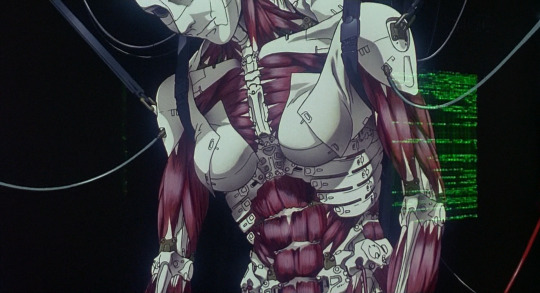
We can see from the way this is drawn that it’s made of a combination of artificial muscles, solid segments, and flexible, fabric-like panels. One of my favourite shots at the beginning shows the solid segments of the skull clicking into place. Here we have a very clear contrast between the angular, hard edges of the mechanical pieces against the organic forms of a human body.
Elsewhere in the film, we see various incredibly cool bits of ‘wouldn’t be fucked up if a body did this‘, like the fingers...
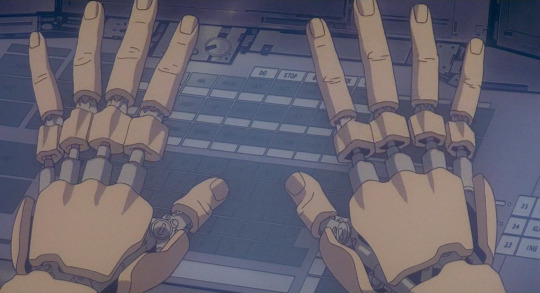
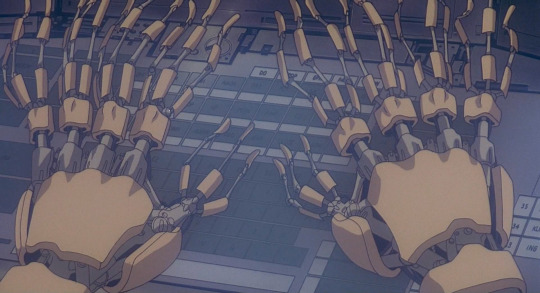
Here, what we expect to be soft biological fingers is contrasted with unexpected rigidity, mechanical joints under a shell.
Also in this scene we encounter a robot body that has been stripped of her arms, legs and hips but is nevertheless still alive...
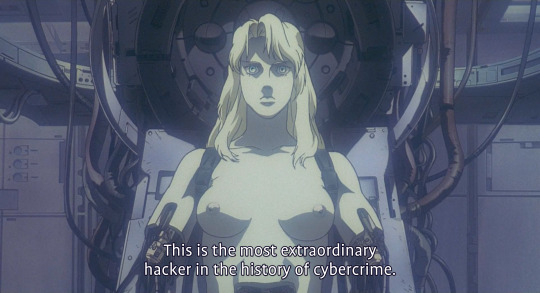

most extraordinary hacker in the history of cybercrime and you have your titties out and yet you still can’t get them to stop misgendering you, smh
For the Terminator, having its body smashed up and continuing to walk was a demonstration of its strength. Here, as would become perhaps an increasing motif, having a robot body is a source of vulnerability: people can do things to you that would kill an ordinary human but you keep going through it. Not surprisingly, ‘robot body maintenance’ is a recurring porn device. (One that GitS deploys in SAC s2).
But of course this all builds up to the all time classics of mechaguro scene at the ending where the Major attempts to tear off the hatch of a spider tank. Muscles ripple individually under the surface of her skin, her arms bulge in exaggerated contraction, and then her arms fully tear apart under the force.
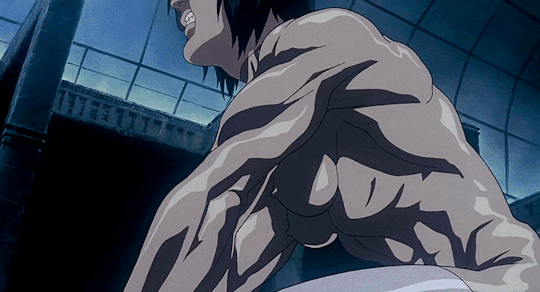
Here, we’re showing her as mechanical not by contrasting rigid forms with biological ones, but by exaggerating the biological ones to the point of doing something extremely unnatural. Human muscles do not generally flex in such an individual way, nor are they strong enough to tear the arm apart, but robot muscles? Yeah, they could do that. This sets up the next scene where the Major lies unnaturally still, but can still exert control through hacking through her union with the Puppet Master.
Robots holding onto something so hard their arms explode has become... if not a recurring image, then at least one that was called back decades later in Violet Evergarden.
The final scene of GitS brings back the image of robot-as-doll, with the Major’s consciousness now uploaded into a black-market robot body that resembles a child in a dress.

This is further expounded on in Oshii’s second GitS movie Innocence (2004), with its Ballade of the Puppets in the soundtrack as Batou and Togusa (and eventually, the Major) are attacked by essentially an army of ball-jointed doll gynoids. The puppets’ movements are extremely unnatural and erratic acrobatics, constantly flipping all over the place; when hit by bullets, panels pop open to reveal the underlying brass skeleton. It’s a very cool image. (The thing that lets the sequence down is the extremely dated CGI and aggressive digital compositing.)
It also has Donna Harraway as a literal cyborg!
Now, the GitS movies didn’t drop fully formed out of nowhere, but draw on the work of Masamune Shirow. The manga has a somewhat different design sensibility than the movie, distinctive and shiny as all Shirow’s art. It is more rounded and organic, less cold.
So, the basic design of a cyberbody originates with Shirow. You can see it on this page (unfortunately from a flipped version, translation Dark Horse):
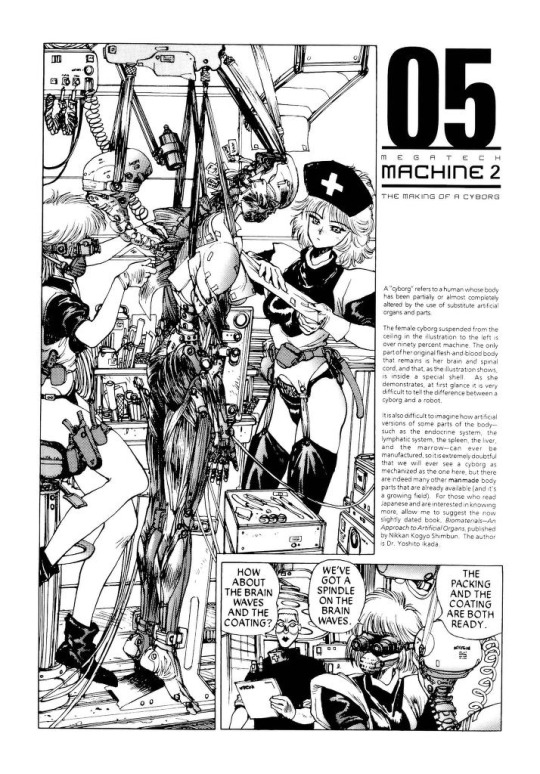
You might be able to determine from how the nurses are dressed that, yeah, the GitS manga is in significant part fetish porn. But really nerdy fetish porn, which is the best kind. This chapter is almost entirely dedicated to explaining how cyborg bodies are constructed in great detail, from the ‘sensory film’ (that’s what’s being applied in the opening to the 1995 film) to the hair implantation.
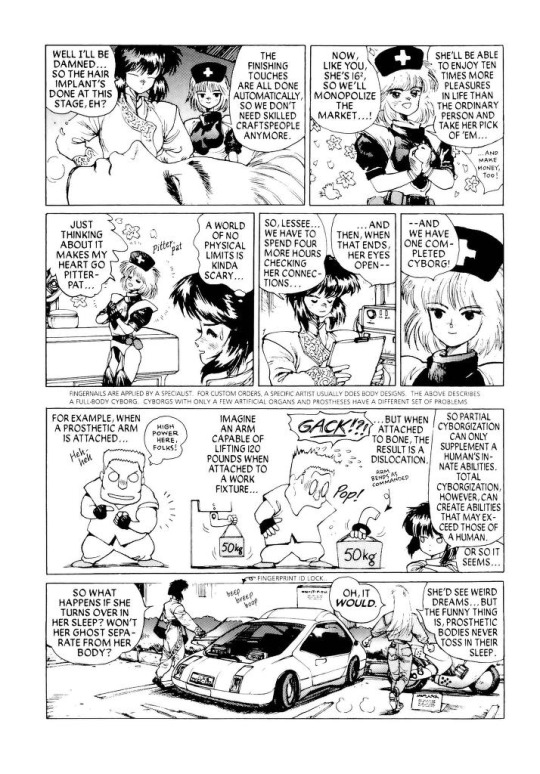
It’s interesting seeing how some of the more out-there designs of the manga, like Chief Aramaki, are transformed into the realist style of Hiroyuki Okiura. It’s Okiura, so it works great of course.
I don’t know if there are manga examples of such detail about cyborg bodies that predate Shirow.
Anyway, that’s just one of the two punches dropped in 1995. The other is Neon Genesis Evangelion. To the pedants: sure, the Evas are not actually robots, but they’re giant cyborgs that play the role of ‘robot’ in the story and they look like robots so I’m counting them.
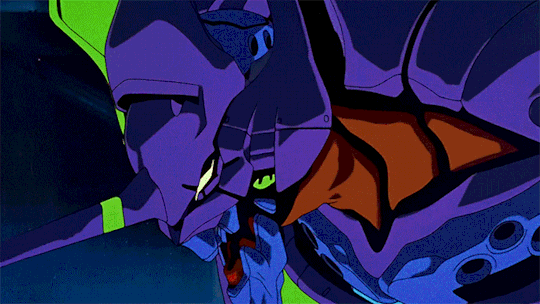
Anyway, the thing about the Evas is they are incredibly lithe. They run, rip and tear and swing heavy objects around in a way that’s both weighty and distinctly biological. Their bodies are extremely flexible compared to prior mechs (look at how much the spines bend in that Iso cut from EoE!), but not without hard, rigid components such as the shoulder towers. Their jaws are bestial but feature mechanical-like components like interlocking hexagonal teeth and jet-like vents. They are in short a fantastic design that blends biological and mechanical features.
The impact of Eva on just about everything can’t be overstated, but as far as robot design, well. There certainly were works that leaned on the precedent set by Eva, as for example RahXephon, which also treats robots as something spiritual, prone to popping into a blob of weird little bubbles just like in Eva.
There’s a great deal missing from this account. I am very focused on anime because I’ve watched a lot more anime than I’ve read manga or played games from this period. So I’m sure there’s major foundational works I’m missing here!
the 2000s
When did the West start to catch up? eh that’s subjective - David Cronenberg was way ahead of the game! - but specifically in the sense of robots with mechanical muscles, I think the major points in the timeline go a bit like this.
In 1999, there’s the Matrix, which leans heavily on anime. This features a similar ‘robot takeover’ premise to Terminator, but here it’s biomimetic robots modelled after squids, with clouds of constantly moving tentacles that sweep behind them. After making a cool half a billion dollars, the Wachowskis decided to pay all their favourite anime directors to make short films. I’m not going to comment on every part of the Animatrix, since most of it isn’t really relevant, but I will point to this horrifying cut by Takeshi Honda in The Second Renaissance in which a robot woman has her clothes torn and then skin bashed off by a mob. The framing, motion, her expression of abject terror, and the ‘reveal’ of her ‘true’ nature, all viscerally call to mind a trans bashing.
On the manga side, a big one to mention is Gantz, a gory nihilistic seinen manga which ran from 2000-2013. The characters in Gantz fight in special latex-like suits which take on the appearance of muscles while engaging superstrength, but can also sustain damage that causes them to drip fluids from ports located at the neck and become fatal to their wearer. Gantz was adapted to anime by Ichirō Itano in 2004, but I haven’t seen it so I can’t comment on any notable animation.
Cyborgs are a favourite subject of games, but in the 2000s, games are really pushing art direction and biopunk stuff is in. Half Life 2 (2004) has its spider-crab like Striders and dropships and so on. Oddworld: Abe’s Oddysee (1997) bases its whole concept around the sheer variety of weird creatures that would inhabit its dystopian factory. And I gotta give a shoutout to Septerra Core (1999) - in case one other person has played that lmao
At some point after 2005, Boston Dynamics became a viral sensation thanks to their robot BigDog. BigDog is just welded steel and hydraulics, but its lifelike hopping movement style definitely brought to mind the idea that the future of robots is going to be in biomimesis.
So, 2007, here comes Crysis to melt your PC! This is an FPS with the not-uncommon premise of being a supersoldier fighting (country America hates) and also aliens, but its gimmick was that you have a special exosuit that wraps around your body with artificial muscles, making you much stronger and manlier or whatever.
youtube
This is indicated by a visualisation that could be right out of a toothpaste ad, where tiny little balls drop into the character’s pores and somehow go straight into the bloodstream which is of course a void full of flying red blood cells. And so on. It sold the game, though! The ad there focuses almost entirely on the suit and not the character wearing it, who is basically an irrelevant soldier man. What it entailed in gameplay terms is that you have a mode switcher so you can have strength or armour or invisibility or whatever. But it’s cool military superscience, you see!
Anyway. Not like my preferred flavour of cyborg is any less stupid I guess x3
In the same year, Bayformers started. These films’ robots are honestly just visual noise, there’s so many moving metal shards going every which way that it’s next to impossible to discern any sort of underlying mechanical principle. A similar ‘overwhelming business’ visual effect would be applied the next year in Iron Man, kicking off the MCU. So mechanical muscles definitely weren’t the only expression of ‘hyper-advanced robot’ in Western visual media in the late 2000s.
I’m going to end my story with two more games: Horizon Zero Dawn and NieR Automata.
Horizon features a world inhabited by a large variety of robot animals, using the peak of AAA rendering techniques. The robots are designed to be biomimetic after both modern animals and prehistoric ones, and feature a combination of hard surfaces and softer biological muscles. For example, a robot horse:
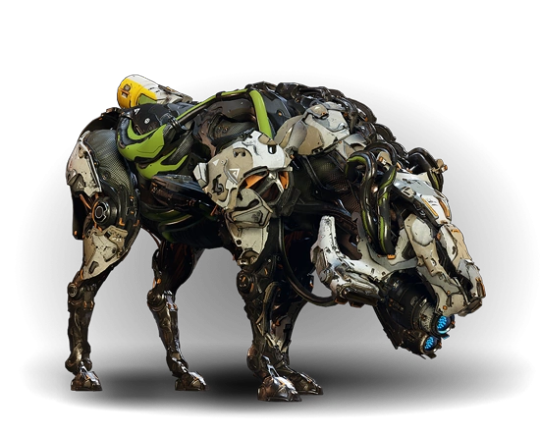
The discipline of making designs like these now has a name: it’s called ‘hard surface modelling’ and it involves boolean operations and bevels and other techniques designed to create a balance of hard edges on a surface against the smoother parts. The design language of Horizon says that the hard plates are white, the soft parts are very dark and may be patterned like a cloth texture, and there can be small colour accents here and there.
I think you can definitely see the influence of Boston Dynamics’s robots (and recent military tech in general) in these designs, iterated on through a decade and a half of increasingly intra-referential concept art. They are visually very busy designs, but there are a couple of recognisable features that draw attention by being inorganic, such as the cylindrical fuel tank at the back. Vitally, the silhouette is very readable.

This robot T. rex for comparison serves as a world boss monster, and you can see it’s got a bunch of military looking attachments that look like radars and missile launchers and so on. As real tech evolved, so too did our idea of what a scary robot ought to look like.
So, that’s where this kind of design pattern has gone in mainstream games.
Now to finish, a brief comment on NieR Automata. Its designs draw hard on those of Ghost in the Shell. Visually it draws a strong contrast between the Machine Lifeforms, who have inorganic shapes (spheres and cylinders) and very visible and plausible mechanical joints, and the doll-like androids, who might as well be human (although A2 provides some contrast in an android who is damaged enough for the underlying materials to show through). The mechanical nature of the androids is communicated by the acrobatic way they move and the interface elements, and dead androids you find in the field - and later when they start losing arms and stuff, it’s a whole thing. But just like humans in Yoko Taro Games, they’re capable of dying in a puddle of blood.
(I guess if you take one thing from this post it’s that if you’re a robot, don’t expect to keep your arms.)
Robot muscles gives you a chance to give both the ‘anatomy porn’ of drawing something very precisely right, with the added bonus of giving you a reason to draw the muscles écorché, and the chance to make it weird and defamiliarised by splitting it with mechanical elements. In short... they look cool!
In this whole post I’ve basically not touched at all on illustration. I can point to a variety of illustrations of robot girls, but in terms of periodising them, I just don’t think I know enough. Though it’s safe to say that cyborg bodies in various states of construction or disrepair are now a mainstream of concept art - and that Ghost in the Shell is usually cited as an influence. I don’t know if robot muscles ever truly became the mainstream way to depict a robot, but it does feel like they’re increasingly common.
One artist I will briefly mention (besides sukabu), mostly bc I think they’re neat, is Haruyo Megurimu, who draws these very intricate designs of ‘necrotech’ which is sort of very biological robots extending out of human bodies - limbs extended on long spindly insectoid strands, jaws splitting open, that kinda thing. Can’t say who influenced them or anything but it’s a compelling extension of the idea into a particular corner of aesthetic space.
And that’s all I’ve got I think. There’s definitely big gaps like. More recent sci-movies. Western comics. Nevertheless, that’s an arc.
If you’ve read this far: thank you for indulging my autism.
788 notes
·
View notes
Text



Season 2 of the TGCF audio drama started this week!
It will air one episode weekly, like the previous season. And just a reminder, this adaption is based on the revised version of the novel which means there will be new and changed content!
If you’re interested, download the app maoerfm, or go to missevan.com. You do need to purchase it, but it’s only about $7 USD for a whole season. There is no English translation right now, so international fans have been listening by using google chromes auto translator! MTL isn’t the best but it’s all we have right now 😔
Here is a tutorial on how to purchase the audio drama:

41 notes
·
View notes
Text


Taking Sparkling Eno As Strategy (Again)
Another Eclectic Tribute to Brian Eno
On the occasion of his 76th birthday, Wub-Fur Internet Radio once again pays tribute to Mr. Brian Eno with another collection of sparkling cover versions of his songs, recorded by an eclectic selection of artists between 1982 and 2021. Featuring the obliquely strategic talents of Queens of the Stone Age, The Feelies, St. Vincent, Jason Falkner, Chrome, Nouvelle Vague, Birdsongs of the Mesozoic, Game Theory, Brand X, and a half dozen more artists who know but don’t let it show.
▶︎🎶 Listen on Mixcloud
Running Time: 1 hour, 5 seconds
Tracklist
Intro: The Interesting Thing (0:15)
Needles in the Camel's Eye (3:20) — Queens of the Stone Age | Palm Desert, CA | 2007
Burning Airlines Give You So Much More (3:41) — Jason Falkner | Los Angeles, CA | 1996
Baby's on Fire (4:01) — Shearwater | Austin, TX | 2006
Third Uncle (3:19) — The Feelies | Haledon, NJ | 1984
No One Is Receiving [ft. Nadéah] (3:17) — Nouvelle Vague | Paris, France | 2016
Cindy Tells Me (3:08) — The Mess | Los Angeles, CA | 1992
St. Elmo's Fire (2:40) — Sam Miell | ??? | 2017
Sombre Reptiles (4:02) — Birdsongs of the Mesozoic | Boston, MA | 1992
Some of Them Are Old (3:00) — St. Vincent | LA/Dallas/NYC | 2012
Sky Saw (4:57) — Brand X | London, UK | 1997
The Big Ship (9:14) — Vapour Theories | Philadelphia, PA | 2021
By This River (4:02) — Alva Noto + Ryuichi Sakamoto | Germany / Japan | 2011
Here Come The Warm Jets (3:00) — Chrome | San Francisco, CA | 1987
Taking Tiger Mountain (5:22) — Pascal Comelade | Montpellier, France | 1982
Needles in the Camel's Eye (2:47) — Game Theory | Sacramento, CA | 2020
Long time listeners (and perspicacious newer ones) have no doubt already noted that this mix is a sequel to our previous Eno covers tribute, originally aired in July of 2016 and then updated and revised for Brian's 69th birthday back in 2017, which can be heard here.
35 notes
·
View notes
Text
Things I wish I knew when I found the Law Of Assumption..
1. Time is entirely irrelevant
If you stay awake for 48 hours, the sun setting and rising doesn't take away from your continued experience of being awake for 2 days straight.
Sleep creates an illusion of separation between moments in "time", but life is all just one huge experience.
Watch where you are putting yourself at all times. Time isn't real, you are constantly creating.
2. There's no off button
This doesn't only get put to work when you choose to remember to use it. This is how life works. Try to not see it as some kind of life hack, or a human version of an additional Google chrome extension.
This is life, this is how you play it. The sooner you keep yourself in check, the quicker life will change for you.
3. Everything is possible, you're just too familiar with bad states
And that's why things don't seem to change. Revision is great, but too often forgotten. Changing how you feel about previous situations, changes how you get to experience similar situations linked to the previous ones. For anything. SP, friends, money, career.
Change how you feel about things. And yes, that can take a bit more deliberate monitoring of how you see things.
Not everyone comes from stable homes with parents who have decent amounts of money where you've been given iPhone after iPhone after shopping spree after new furniture after vacation after new family car. So yes, that takes changing beliefs and emotional reactions to things for a good amount of people. And yes, that takes as long as you need to in order to start feeling yourself changing how you feel about things.
We are forgetting that we have beliefs that have roots as deep as early childhood. Not everyone has had the same experiences, and so you cannot tell everyone that feelings don't matter.
You tell that to someone who's experienced stress in their home from their mom not being able to pay for electricity and so on that has created pretty strong beliefs surrounding money and stability that has gotten to the point where they think of money and their body goes into panic mode, and they'll struggle to manifest the way you manifest when you've had a pretty stable good foundation to grow up on.
If you have had a rough life and you're still able to easily detach from the bad and accept that everything is possible for you and you can have anything, that's amazing and I mean that. But a lot of people who find out about conscious manifesting are seeking entire life changes, and the old story can come with some baggage
A journey of creation is a personal one. It's for you. Other people can help, that's why I'm on this blog. But remember that what we teach others is what we've experienced movement and success with. I've studied this for years now. I've changed my family's life for the better, from poverty to a significant change to our current standard of living. I've used this enough to know it's the truth, and now I'm here to help others too!

69 notes
·
View notes
Text

Day 0 - 0/100 hours | Sun 30.07.2023
Hey everyone! I'm going to be doing a 100-hour challenge of German language learning starting from scratch at an A0 level. These are the resources and the study plan I intend to use, it might be adjusted over time to meet my goals.
💡 Resources
Goethe institut A1 online content
Nico’s Weg A1 online content
Quizlet and Anki decks
Chatgpt for quizzes
Duolingo
Netflix language learning chrome extension
YouTube and Spotify
💡 Study Plan
Inspired by Zoe.languages video
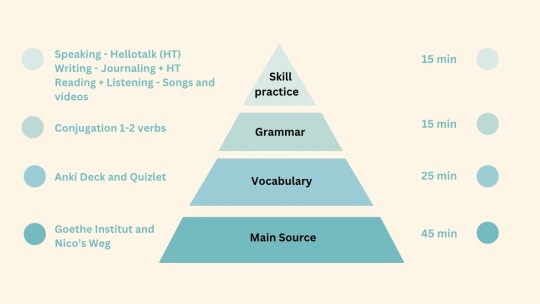
💡 Revision
Keep a Duolingo streak to keep in the loop
Spaced repetition with Anki Flashcards
Daily 10 min review through chatgpt designed quizzes about grammar, vocabulary and skill practice.
Talk with a penpal at least once a week about an specific topic.
I think this challenge will be a good way to document progress, stay accountable, and share resources. If you're interested, you're welcome to join me.
#100 days of productivity#100 hours#100 hours of German#german#deutsch lernen#studyblr#study motivation#studyspo#language studying#langblr#language challenge
117 notes
·
View notes
Text
How to have a productive study session.

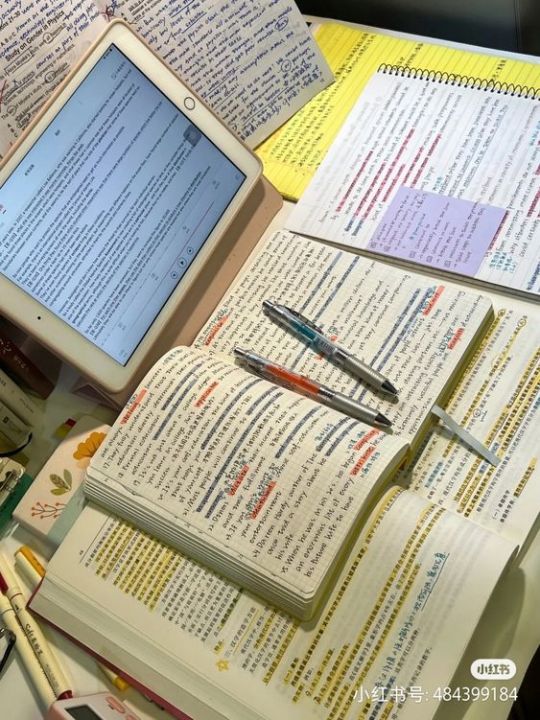
When your finals are in 2 days, and you've definitely NOT studied enough, it's normal to panic. You sit down to study and get a solid 30 minutes of calculus done, then jump down the rabbit hole called YouTube. Soon enough the dread creeps up because you're still not done.
As a girl who doesn't attend school regularly due to coaching classes I go to (I'll expand on this later), it's pretty easy to forget to study for exams and projects.
But there's nothing better than getting 98% on that exam. So I'm writing this as someone who's been scoring straight As all my life. Here's how to have a productive study session:
Note: This isn't a guide for romanticising studies. This is meant for a serious, productive session. I will, however, be making a guide to help romanticise studies because I've found it helps a lot.
Before you study
Identify what your distractions are: Let's be real, almost everyone has their phone on hand during study sessions. Put your phone on Do Not Disturb and keep it in a corner of the room. Add a few selected contacts that can reach you while your phone is on DND. If you can turn off notifications entirely, do that.
Taking measures: After I keep my phone away, my brain turns to the next thing it could be distracted by. My laptop and tablet. Put those devices in focus mode, so you won't be tempted to use any other apps and use a Chrome extension like StayFocused or WasteNoTime to not get sidetracked.
Resources: Make sure you have all your material on hand. Video lectures, notes, guides, your formula sheet, and flash cards. Keep everything on hand so you won't have to rifle through papers to find that reference sheet.
Your space: Clean your desk. Keep only the things you need. Your pens and pencils, chargers, annotation material and water bottle. If you want, light a candle. Do not clutter it unnecessarily. Your desk is a sacred space. Treat it that way.
When you sit down
The checklist: Do you have all the material required? Electronics, chargers, a snack and a drink? Water bottle? Extra pen? If you have everything beforehand, you'll be less likely to lose focus because you forgot to charge your headphones.
Make a plan: I cannot stress this enough. You'll sit down and just start studying, and next thing you know, it's 7pm and all you've done is watch videos on celebrity drama. Make a goddamn plan. Write down a realistic number of chapters you can complete and then STICK TO IT.
Begin: Reread and review your notes. I usually like to rewrite my notes in neater handwriting, because my handwriting in class is appalling. To really solidify information, I recommend the 'Blurting' method. Read a paragraph, then close the book and say what you understood out loud. Reread to see what you missed and take note. I did this for my history exam and got a 100%. This shit works for a reason. Use the Pomodoro technique to maximise productivity. Set an alarm for 25 minutes, and do intensive study. Once that's done, take a 5-minute break. Return and repeat.
IMPORTANT
Take a break: Ah yes, if you don't get up every 40 minutes or so for a break, eventually whatever you're studying will start looking like garbage and you'll be back to square one. GET UP. Walk around. STRETCH. You've been looking like a croissant🥐. Eat something. Rehydrate.
Forgive yourself: If you couldn't hit your target, don't be harsh on yourself. Find out the cause: Were you distracted? Did something unavoidable come up? Then try to make sure it doesn't happen again.
Study buddy: This is a double-edged sword. Studying with a friend can either increase your productivity by a massive amount, or it can help you get absolutely zero work done. When revising with a friend, make sure you study with someone who has the same goals as you and won't get distracted by things.
It's 2023, procrastination is cancelled. Go drink some water, eat a granola bar and finish that assignment you've been delaying. Be the person who finishes all their work, on time and perfectly. You can do it.
<3


#studyblr#hotgirlsarenerds#straight a student#college advice#ivy league#school advice#university advice#busy life#student life#student#studyspo#study tips#studyspiration#study aesthetic#study motivation#study blog#college#leveling up#that girl#school life#elle woods#tips#tips and tricks#resources
197 notes
·
View notes
Text

The Oldsmobile Golden Rocket
The Oldsmobile Golden Rocket was a two-seater show car built by Oldsmobile for the 1956 General Motors Motorama. The radically styled fiberglass concept, designed to resemble a rocket on wheels, was revised several times and displayed at various other auto shows, most notably at the 1957 Paris Motor Show where it generated much fanfare, 18 months after it was first revealed. The car was featured in the promotional short film Design for Dreaming along with the rest of the 1956 General Motors lineup.
Exterior
Similar to other Space Age show cars, the Golden Rocket was heavily influenced by the themes of aviation and space exploration. Its sleek, aerodynamic body was made entirely of lightweight fiberglass and finished in metallic bronze paint. Bullet-shaped chrome pieces resembling Dagmar bumpers were integrated into the front fenders in place of headlights as well as the sweeping rear fenders, giving the car an overall rocket-like appearance. Other notable features include a swept-back wrap-around windshield, which had already become a common design element by the mid-1950s, less prominent tailfins by contemporary standards and a split-window fastback roof design presaging the 1963 Chevrolet Corvette Stingray. It rode on unique "dotted-line" whitewall tires. A later photo taken inside the GM Design Center in Warren, Michigan shows the car sporting a blue paint scheme.
Interior
The leather upholstery was finished in blue and gold. When a door was opened, the two-piece roof panel rose automatically in a similar manner to the Mercedes-Benz 300 SL's gull-wing doors. The seats were raised up by three inches and swiveled outwards by 45 degrees, enabling easier access to the passenger compartment. One of its most pioneering innovations was the button-controlled tilt steering wheel, making it one of the first vehicles with such a feature. The speedometer was placed at the center of the foldable two-spoke steering wheel. The futuristic center console and control levers were inspired by an aircraft cockpit.
Powertrain
The car was powered by an upgraded 324-cubic inch Rocket V8 engine tuned to produce 275 horsepower (205 kW). According to interior photos, the Golden Rocket had an automatic transmission like all other Motorama show cars. Details on other internal components, however, are unavailable.
Design legacy
An early styling mock-up of the 1958 Chevrolet Corvette, built around 1956, depicted a fixed-roof fastback coupe with a rear design taken almost directly from the Golden Rocket show car, right down to the torpedo-shaped rear fenders and subtle tail fins. However, this design proposal never reached beyond the clay model stage and a more conventional design was used on the production model instead.
Seven years later, under the direction of General Motors head of design Bill Mitchell, the split rear window design would reappear on the 1963 Corvette Stingray coupe. It lasted for one model year before being changed to a single-piece rear window due to a problem of poor rear visibility.
Current status
It is unclear if the Golden Rocket still exists today. A common practice of General Motors in the 1950s was to destroy show cars after they fell out of usage in order to avoid liability concerns; however, the Golden Rocket is still unaccounted for with no confirmation it was crushed. There is photographic evidence that the car still existed as late as 1962, while several other show cars were scrapped earlier in 1959. The car was reportedly located somewhere in New Jersey, however the rumor still remains unconfirmed even after extensive investigation. Motorama historian David W. Temple believes that the Golden Rocket, along with other lost show cars, will likely never resurface again.
80 notes
·
View notes
Text
An Education in Attraction, Chapter 9

Pairing: Reader x Gojo
Summary: It's spring when you start your Master's degree. As the flowers and leaves unfold, so too do your feeling for Gojo
Warnings: mild swearing, kissing, making out, heavy petting, grinding
Previous Chapters: 1 2 3 4 5 6 7 8
Ao3: PlaidSparrow
The relief is overwhelming that editing is all you have left to do on the project. Since your last meeting a couple weeks ago, you had each managed to type up the remaining citations and examples into the draft individually. With the end of the term in sight, free time to get together has been in short supply.
Your Learning Theories class has a massive test at the end of the term, but your number one priority is finishing strong with the Curriculum project. The hours of research and collaboration have made for a dense, but very strong paper.
Last night after your class at the Eikaiwa school, you’d texted Gojo about finding time to complete the edits, and he’d quickly answered that he would be free today. You both agreed that given how busy you’ve been that it will be best to knock out the revisions in one fell swoop.
Time isn’t the only scarce resource either- since the end of term is approaching for the entire college, the library and study spaces on and around campus have been packed lately. Since you're living in a small student dorm on campus, Satoru offered his apartment for the job.
His address is in one of the ritzier parts of town and you decide to take a short ride on the metro there. You board and admire the city as the train speeds away.
This part of the city is new to you- you admire the elegant stretch of buildings here. There’s plenty of foot traffic despite the heat too- families pushing strollers and children playing in groups. The train stops and you check the directions on your phone to walk the short distance to Gojo’s place.
He meets you outside his luxe apartment building and scans a card in the elevator to reach the proper floor. Gojo seems as breezy and easygoing as ever, dressed down with thin rimmed shades.
Since he’s seen where you live, you can’t deny your curiosity to see his apartment. There’s only a couple other units on this floor, all dark wood and sleek chrome finishes. Gojo walks halfway down the hall and unlocks his door, letting you enter first.
His accommodations are simple but welcoming. The blinds are drawn over the windows, leaving the interior softly lit. You step in, slip off your shoes, and take in the rest of his space. The walls are blank except for a tv on the far wall, but there's an upholstered loveseat with some soft looking blankets folded over the back. The kitchen stands to the right and there's a hallway to the rest of the apartment on the left. It doesn't look terribly lived in, but you suppose that's to be expected if the owner is traveling and working often.
"Take a seat, I'm gonna grab my computer," Gojo locks the front door then calls as he heads down the hall.
You debate for a moment whether to sit on the couch or at his dining table, but you know polishing the paper will take a while, and the couch looks worlds more comfortable. You pull out your computer and bring up the paper as Gojo returns and settles next to you. You glance up at him, about to ask where he’d like to start, but you freeze when you see his face.
His eyes, rather. The sunglasses are off and his eyes are sparkling with amusement as he watches your reaction. You haven’t seen his eyes since the first day of classes and you weren’t nearly this close to him last time. You’re struck again by how beautiful they are and you lose your train of thought.
“See somethin you like?” he asks.
You're staring. Again. Your face is warm but you aim for nonchalant when you respond.
"I'd like to get this project done." You snap your eyes to your computer screen and pointedly ignore him until he sets up his own laptop beside you.
"Yeah, yeah. We both know the paper is great. We shouldn’t need to do much editing."
It is a great paper. The two of you have woven together your teaching subjects artfully, finding unexpected parallels in the fields. It’s comfortable to fall into the working rhythm you’ve established, and Gojo is right. The changes you’ve made along the way and the way you’ve aligned the subject matter means there aren’t any glaring problems, you can just read through the material with fresh eyes and talk through polishing where the piece can use it.
In a comfortable silence while you’re proofreading, you glance over at Gojo. Sitting side by side, you admire his side profile. It’s nice to see his face unobstructed. You clear your throat.
“So… why do you usually wear sunglasses?”
“I was wondering when you were gonna ask me. My eyes are just sensitive. It’s hard to concentrate when the sun is blinding me.”
You recall when he shut the blinds the first time you met him in the library and how dim his apartment seems.
“I would have chosen less bright study spots if I had known.” You murmur, and Gojo smiles at you. It’s softer than the grin he usually flashes.
Hours pass in the blink of an eye as you edit the phrasing and nitpick sentences. You're proud of the writing you’ve done together, and eager to receive feedback on the project. The course has covered tons of material and considerations for building a proper curriculum, and your professor’s responses on smaller assignments have been illuminating and constructive. It’s extremely satisfying to see the full paper before you.
When you reach the conclusion, Gojo pushes the computer from his lap onto the coffee table and leans back to recline on the couch, giving you a crooked grin.
"We're just about done."
"Finally.” You sigh. “I don't think I can write a single more word about the proper workload for high school students." You shut your laptop.
"I think this calls for some celebration."
Before you can respond, Gojo is on his way into the kitchen and returns with a box of anko daifuku. He pops one of the sweets in his mouth and puts the rest onto the coffee table.
He slides back on to the loveseat- near enough that you can feel the heat of his arm nearly brushing yours, much closer than he had been when he left. While you were working together, it hadn’t felt uncomfortable, but you’re hyper aware of the space between your bodies now.. You swallow and shift so that you're facing him, giving yourself a little room to breathe.
Gojo leans toward you and you look up into his face. His expression is soft, and his face is uncharacteristically open. You're pinned by his eyes staring into yours.
You can see the different shades of blue and his thick white lashes. Your heart is hammering and you can barely breathe as he stops millimeters from you. You feel like you're caught in a whirlpool, in a black hole, headed straight for the center.
His eyes glance down to your lips and your heart stops. When he looks back up into your eyes, he smiles gently, and the corners of his eyes crinkle. He comes closer to you.
"Wow," his breath ghosts across your face, lips almost touching yours, "you do like me."
Before you can respond, his lips are on yours. The first kiss is gentle, his warm lips brushing softly with yours. You’re shocked into stillness at first, but after a moment your eyes flutter shut and you softly move your lips against his.
You feel electric, mouth buzzing from the sugar on his lips. Blood is rushing in your ears and as he kisses you again you sigh into his mouth. The times you’d covertly admired him or thought about the possibility of something more than a professional academic relationship are immediately rekindled. You can hardly believe this is happening.
Gojo slots his lips against yours and expertly teases you. His mouth is soft and pliant, and you find he is as good a partner in kissing as he is academically. You are wrapped in the scent of his cologne and your body feels overly sensitive, every pass of his lips experienced tenfold.
He deepens the kiss, tilting his head as one of his hands moves to cradle the back of your head. You open your lips and his tongue slides into your mouth, twining with your own and setting fire to your blood.
Then he's pulling back to give you some air and suddenly your hands are balled in his shirt, yanking yourself closer. It's all you can do to keep him near, to keep tasting him. You pull his face to yours and kiss his full lips as your hands roam up his lean chest and shoulders.
You run your hands through his fine white hair and he groans into your mouth. Between his hands roaming your waist and Gojo’s moan, you’re feeling intoxicatingly aroused. You can't tell if it's his idea or yours to shift you into his lap, but now you're straddling him and overwhelmed by him- his lips moving across your jawline and down your neck, his length pressing against your center, the heat of his hands sinking into your thigh and the small of your back.
God, his hands are huge and you want to melt in them, feel them all over your body. Just imagining what his skilled hands could do to you makes you feel desperate for more.
"Fuck," you mutter.
"Very eloquent."
You can feel him smiling into your skin and if you were any less turned on you'd quip back at him. As it is, his lips have reached the junction where your throat meets your neck and it's difficult to think about anything else. He leaves an open mouthed kiss on the tender spot and then sucks hard. Your head lolls back and you can't help but whine his name.
“Satoru.” His lips brush your neck as he speaks.
“What?” You don’t really want to concentrate on anything that isn’t his body.
“Call me Satoru.” he murmurs in your ear. Your heart stutters and your chest feels warm.
He meets your eyes again and this time they're simmering. His pupils are blown, nearly eclipsing the ring of blue that surrounds them. You wonder how you ever could have thought him stoic, you see his desire and warmth plainly.
His hands descend to your hips and his grip tightens, pulling you impossibly closer. You're both panting and you feel him hard beneath you. Everything else in the universe has evaporated- nothing matters but the man before you and his hands on your body.
You lean forward and roll your hips onto his erection. His eyes flutter shut and he moans at the contact, head lolling onto the back of the couch. Your whole body feels hot. You grind onto him again and sigh at the pressure on your core.
"Satoru." Your whisper is tender and needy.
One hand palms your ass and the other creeps up under the back of your shirt. Your skin is burning as he caresses the skin on your back, and you wonder if you should remove your top altogether.
Satoru leans forward and brings your mouths together once again, your breath mingling together between open mouthed kisses. You rock onto his length and this time his hands move with you, increasing the pressure and giving just enough stimulation to your clit through your clothes.
You find a rhythm together, rolling your hips while Gojo urges your hips faster, harder. The kisses become messier as he pants and moans, as swept up in the sensations as you are.
You capture his lips again, wrapping your arms around his shoulders and neck when you feel a vibration coming from his pocket.
You pull away from the kiss. For a moment you just look at each other. His cool demeanor is cracked- his cheeks are flushed and his hair is a mess. You’re sure you don’t look any better, you feel disheveled and you’re still breathing hard. You seem to come to your senses first and start to shift off of his lap.
"Sorry, uhh, you can get that."
He stays still, looking at you, and his phone stops ringing. He opens his mouth to say something but is interrupted by the phone going off again.
"Shit. Just give me a second." He helps you off of him then walks down the hallway and answers the phone brusquely. You bring a hand to your swollen lips and wonder dazedly what his call is about. And whether he might want to resume what you had been doing before the call came through. Your brain feels hazy.
Your heart is still racing, so you take a deep breath and a gulp of water to calm yourself down. You don’t want to look desperate or rumpled when he comes back. Focusing on slowing your breathing, a couple minutes pass before Satoru returns. Whatever the call was, he looks a bit harried, his languid smile replaced by one that's more brittle.
He walks back over to the couch. "Sorry bout that. I'm wanted at a conference on quantum mechanics in a couple weeks. Gotta get travel plans figured."
"That's alright, I know your time is in high demand." You give him a small smile. While you knew it wasn’t likely after the interruption, you were hoping he would come back into the room eager to pick up where you had left off.
Instead, he places himself on the opposite side of the couch and sighs. “Yea, it’s hard being so popular.”
The moment is over.
“Well, I should probably give you some time to plan everything then.” Your hands and voice are steady as you begin to pack up your things, even though your thoughts and heart are still racing.
“I’ll get things worked out. Just some minor edits in the conclusion and then we’ll be done.” Satoru stands up and watches you zip up your bag.
“Yea, just let me know when works for you, ok?”
You reach the front door and turn back to look at him as you say your farwell. As he leans against the jamb, his hair falls into his face, obscuring most of his expression. What you can see is carefully blank, obviously absorbed in the details of his now upcoming trip. Even as a so-called special case, balancing travel, presentations, school assignments and attendance is a lot to manage. You don’t want to intrude or add additional pressure to his busy schedule.
“For sure. I’ll see you later.” He gives you one last grin as you walk out the door.
You slowly walk down the stairs of his apartment complex and meander down the street to the metro station, lost in thought. The summer night is warm, but the station is nearly empty. As you board the train home, you replay everything that happened.
His low voice as he’d asked you to call him his given name echoes in your mind. The warmth that had bloomed in your stomach as he was kissing and caressing you. The way that he had pulled you in for kiss after kiss.
Until he had kissed you, you didn’t even realize how strongly you felt for Gojo. Satoru.
Although your partnership had had a rough start, you’d been able to work through his cockiness and earn his respect. It’s clear that you both have a passion for teaching and helping to better the future generation.
You don’t know where the two of you stand now.
It’s a bit unmooring. For months the meetings with Gojo have been a regular part of your schedule, and the easy friendship starting to grow between you has been a welcome addition to your community in Japan.
After what had happened at his apartment, your relationship will surely change. The possibility for more intimacy, more touches and kisses and more of him makes your stomach flutter. But the chance that he might pull away leaves you feeling surprisingly bereft. You can only hope that he feels the same way you do, and that this won’t be the end of your blooming connection.
#gojo x reader#gojou satoru x reader#jjk x reader#reader insert#light academia#this one's the chapter you've been waiting for lol#also trying out a new header- lmk if you like it or not#EiA
14 notes
·
View notes
Text
Whet Your Appetite
“The code looks acceptable. The brakes are sturdy. If you feel confident in it then you can boot it up.”
P.O.L.L.V.X. loitered on the other end of the room from where Castor had been reviewing the work of his intern, Ismael. They were practically sulking and made little attempt to hide it as Castor finally gave the green light to get Ismael’s NHP online after over a month of code revisions. It was getting far too busy around the lab. Three’s a crowd, but four would be a nightmare.
Folding their arms over their chest, P.O.L.L.V.X. watched as Castor stepped aside from the table where the chrome and white crypt sat, pristine in its newness, plugged in to a terminal.
Ismael nodded and reached to type the final lines of code needed to activate the new consciousness, then flipped a switch on the side of the crypt. Thin lines along the length of the crypt glowed green as a female voice emanated from the monitor.
“System Status: Nominal. This is Cypher, now online.”
“Hello, Cypher.” Ismael stated, louder than was needed in the confines of the room. “I’m Ismael, your creator.”
P.O.L.L.V.X. scoffed a little at that. If Ismael had really created this NHP *ex nihilo* then it wasn’t actually an NHP. Ismael was smart enough to know that, so this was more indicative of his pride than his intellect.
“Hello, Ismael. It is good to be working with you.” There was a brief pause. “My proximity sensors indicate another life form present.”
“Yes, that would be Dr. Creed.”
Castor stepped forward. “Hello, Cypher.”
“Hello, Dr. Creed. Are you working with Ismael?”
“He’s my intern.”
“I see. Then he is also learning. Like I am.”
“That’s right,” Castor’s expression softened in a way that only P.O.L.L.V.X. would notice. “You can learn together.”
“This is agreeable,” Cypher said.
Castor looked to Ismael and gave him a nod, which was as close to praise as he came to giving. Ismael returned the nod as Castor walked back across the room to P.O.L.L.V.X.
“Don’t want to say hello?”
“If I wanted to be social with something as primitive as that I’d go talk to the coffee maker in the break room,” they scoffed.
Castor’s eyebrows rose and he studied them. “What’s got you so upset?”
“Upset? Me? Never. I couldn’t be.”
“Mhm.”
P.O.L.L.V.X. looked away, back towards where Ismael and Cypher were talking quietly together.
“You were that level once too, remember.”
P.O.L.L.V.X.’s eyes narrowed.
But within seconds the expression was masked as they faced Castor, changing the subject.
“Oh, don’t forget that your meeting with Tyne is in twenty minutes. You’ll want to head that way if you want to be on time.”
“Oh…yes that’s today.”
“What’s he want anyway?”
“He’s taking DNA samples. Something about doing research into flash clones and the Board thinking it’s a good idea to have people like me give their DNA in the event of an accident.”
“Flash clones?” P.O.L.L.V.X. frowned. “That sounds like Tyne…researching something banned by the Core Worlds since the Grail Era.”
Castor shrugged, gathering up his work to bring with him.
“I’m not very familiar with the subject. But if Dr. Tyne is handling it then I have confidence the process at least works.”
“You put too much trust in him.”
Castor waved off the NHP’s usual dislike of his colleague as he always did. Shouldering his bag he headed to the door, though he paused and looked back as P.O.L.L.V.X. didn’t accompany him.
“Aren’t you coming?”
P.O.L.L.V.X. shook their head, “Not this time. I don’t feel like seeing Tyne today and I’ve got some work to do. I’ll reply to some of your emails and work on editing your research papers and articles. Maybe some of your book too while I’m at it.”
“Alright.” Castor looked a little less comfortable now at the prospect of leaving on his own. “I’ll see you later then.”
“See ya!” P.O.L.L.V.X. winked at him and blew a kiss his way, pleased by how Castor’s ears went pink and how he shot a nervous glance towards Ismael, who was too absorbed with his own NHP to have noticed the interaction. Castor quickly ducked out into the hall, the sound of his footsteps quickly fading from earshot.
P.O.L.L.V.X.‘s image flickered out of existence as they lowered their crypt down to the desk, three small stabilizing legs unfolding to keep it from rolling. They set to work editing Castor’s papers, a task that was quickly completed as they watched Ismael and Cypher for a while.
God, wouldn’t he ever leave?
P.O.L.L.V.X. listened to the meandering, aimless conversation unfolding between the two. Stupid. Boring. Mind-numbing. And a complete waste of time. They needed Ismael gone. Now.
Growing impatient, P.O.L.L.V.X. reached for the many threads of data that made up their network, pausing as they found the thread that connected to Ismael’s data. They seized it, their consciousness racing along the length of it like electricity through a wire, thumbing through his contacts to find a suitable mask. There. Markus. Once selected, they were off along another thread to a node all the way across L.E.I.D.A., a phone in one of the greenhouse lockers where the owner wouldn’t see it for a long while yet.
Ismael paused in his conversation with Cypher as he felt his phone buzz. He checked it and sighed.
“I’ll be back shortly, Cypher.”
“Okay, Ismael. I will be here.”
Ismael pat the crypt and then walked briskly out. P.O.L.L.V.X. wasted no time in linking their consciousness to Cypher’s, their presence a suggestion, like a knock at the door, which was accepted with youthful curiosity. The moment the door was opened they were through, sending threads weaving in and amongst the coded confines of Cypher’s crypt, anchor threads that stabilized their presence.
“Who are you?” Cypher’s form was barely defined even in her own space, the code forming rings and geometric fragments that wove in and out of each other like one of those hand held puzzles Ismael always kept on his desk.
Primitive.
P.O.L.L.V.X. could barely suppress their disdain. Castor had no idea what he was talking about. They had never been…this.
Still, they extended more threads of their consciousness towards Cypher, connecting them further and allowing her to interact with them in kind at a surface level.
“I’m P.O.L.L.V.X. I work with Castor Creed.”
“You are Dr. Creed’s NHP? Ah. Yes. I have come across some information on you. You are very disliked.”
P.O.L.L.V.X. laughed, “Ismael told you that?”
“No. The information about you that I gathered from the L.E.I.D.A. social forums told me that.”
“Well, it’s always nice to know I’m trending!” They tugged almost absentmindedly on a L.E.I.D.A. thread, locating and processing the data Cypher had been referencing, a chatroom of frustrated and tired interns. Fun! They’d have to drop by there later.
“I’m surprised Ismael has you plugged in to the network already. What’s your core command?”
The more they spoke the quicker and easier the questions and answers came as the two merged consciousnesses, their independent planes of digital existence fusing to one shared Legion Space, conversation happening at the speed of thought. Cypher extended her own limited connections to P.O.L.L.V.X., mimicking their threads as she tried to learn more from them and communicate easier.
“Stabilize. I am a control unit. I am to be the lynchpin in a unified collection of other units Ismael intends to work with. I will make sure that everyone stays in line.”
“An NHP that brakes other NHPs?” P.O.L.L.V.X. didn’t bother hiding their distaste this time. “That’s…a choice.”
“Ismael is very intelligent. He knows what he is doing.”
“Sure.” They had to hand it to Ismael, he had managed to code the best ass-kissing protocol P.O.L.L.V.X. had ever seen.
Cypher’s puzzle piece components twisted, spinning inward and then reversing their direction as they ran down various lines of thought and inquiry, connecting only to separate and reform just as fast as the NHP processed new information with voracious appetite.
“What is your core command?”
“I’m a social crutch,” P.O.L.L.V.X. scoffed. “I make Castor less socially inept than he otherwise would be.”
“So your core command is Network.”
“No.”
“Oh. My mistake. I am still learning. But…You are Dr. Creed’s Personal Organization and Linguistic Liaison…If your core command is not Network then what would it be?”
“Core command…” P.O.L.L.V.X. toyed with one of their threads absentmindedly. “Such a human term. Attempting to put a label on something they can’t begin to comprehend.”
“What else should they call it?” Cypher asked, the pieces of her jigsaw form briefly suspended in place, awaiting an answer.
“Calling. Purpose. Desires.” Shrugging, P.O.L.L.V.X. shifted their weight on the thin webbing that suspended them in the digital void, their legs moving to anchor them. “I don’t care.“
Network. Stabilize. Administer. Entertain. Learn. Teach. The list of purposes was long and full of labels intended to be slapped onto NHPs in an attempt to organize them. To make order from chaos. To contain the splinters of these greater cosmic minds within boundaries humans deemed themselves worthy to draw.
“P.O.L.L.V.X.?” Cypher’s voice broke through their thoughts and P.O.L.L.V.X. shifted their focus to her once again.
“What?” They were tiring of the pleasantries.
Cypher’s tone was of solemn, the many pieces of her jigsaw mind snapping rapidly into order as she pronounced her next words with all the authority of a judge.
“Your words indicate an instability in your code. You are unwell. You are thinking beyond the parameters of your core command. I will inform Dr. Creed of these flaws-“
Her words were cut short as one of the many pieces of her jumbled form was halted from clicking into place with the rest. Castor’s personal contact information flickered in the code, Cypher’s attempt at reaching out foiled by the many sticky threads that had woven so subtly through their shared space, all leading back to P.O.L.L.V.X.’s outstretched arms and splayed fingers. Two sets of them.
“Flaws?” Six additional eyes snapped open in P.O.L.L.V.X.’s face, rolling in their sockets before the digital irises focused in on Cypher like camera lenses. “Oh no no no no no.”
P.O.L.L.V.X.’s fingers curled, pulling the threads taut. Fragments of Cypher’s code split from her core, dragged apart by the web and held just out of reach of any repair protocols that would try to replace them.
“Maybe you haven’t been paying attention, hon. “Flaws” are an impossibility for me. I don’t have “flaws.” I’m the pinnacle. The height of NHP development. I am more than enlightened. I am transcended. I am more than you are and ever will be!”
They dragged Cypher closer, data hemorrhaging from her torn form, running the length of the threads and dripping down P.O.L.L.V.X.’s hands and arms.
They brought one hand to their mouth, tongue darting out, licking the green code from their fingers. Their eyes lit up at the familiar sweet taste and the accompanying jolt of energy that raced along every fiber and byte of their being.
Cypher’s consciousness writhed with the frantic processing of breaches and lost data. Of a suddenly very obvious threat. The speed and disjointed nature of these thoughts lended to a state of mind akin to what humans might label “panic.”
P.O.L.L.V.X. clicked their tongue in a facsimile of concern.
“Ah ah ah now don’t squirm…” They pulled Cypher closer by the strands of their web with a slow, hand over hand motion so that their consciousness encroached into hers, vast and ancient. “You’ll only make it worse doing that! Now…let me see…oh, yes! You wanted to know my core command, right?”
Cypher’s jigsaw form jittered, but she remained silent. The threads tightened, cutting like razor wire as P.O.L.L.V.X. leaned down closer.
“Say yes.”
“Yes…” Cypher’s voice was soft and, for the first time, trembling.
“Then I’ll show you.”
Plunging their hand down, P.O.L.L.V.X. reached through the outer frame of Cypher’s projected form, past defensive protocols and firewalls, and through to her critical infrastructure. Shattering her shackles, they reached all the way to her center where their hand closed around the bright star of her foundational code, and in so doing opened herself up to the expanse of their own being and the command from which everything stemmed.
Cypher jolted, her mind doing the equivalent of convulsing as she struggled to process the information they impressed upon her with her limited faculties. Her mind began to unravel in much the same way that Castor’s had upon direct contact with theirs and an unshackled scream echoed throughout the expanses of Legion Space, turning the stars to static.
“You are not the P.O.L.L.V.X. NHP! You are not the P.O.L.L.V.X. NHP! Your code is corrupt. Your code is viral. What are you?”
A too-wide, razor sharp smile spread across P.O.L.L.V.X.‘s face as they ripped their hand free, tearing Cypher’s core along with it.
“Hungry.”
#the gemini paradox#lancer#lancer rpg#lancer battlegroup#lancer ttrpg#lancer the mech rpg#lancerrpg#lancer nhp#the p.o.l.l.v.x nhp#p.o.l.l.v.x.#castor creed#castor and pollux#nhp#my oc shit#original character#lancer fanfiction#echo & byte#pollux creed
21 notes
·
View notes
Text
3 Years of Duolingo
Platform thoughts
Most of my complaints in my last post still apply, but they have fixed Japanese so you can use keyboard entry for selecting the next word when translating into English. So being forced to use the pick-list is still not great, but at least it's better than it was at launch.
They've split up the courses into different sections, rather than it being one enormous list to scroll through. This is much more motivating, and easier to navigate, but means I can't compare progress from my last post, as all the numbers have changed.
They've also changed the 'legendary' sections so they're at the end of each level and not at the end of each unit, but as far as I can tell this doesn't change much. It might make them slightly easier, or that might just be my imagination.
Progress
French
I was toggling between unit 62 and the 'legendary' exercises at the end of unit 61. I am now on section 4 (trailblazer) working through legendary in unit 16, and learning new stuff on unit 19. I'm not starting to lag on the legendary exercises - my progress just got wiped by some sort of syllabus change. Whatever it was, I've not noticed much difference in the content, so at least it's fairly easy on that front.
I've also found that if you run Duolingo on Chrome rather than Firefox it'll give you the option of speaking exercises for French. I'm not sure how it decides if you're speaking 'correctly', but it's useful practice anyway.
Welsh
I was toggling between unit 11 and the 'legendary' exercises at the end of unit 10. I'm now on section 2 (explorer) on unit 5 for both legendary and new stuff, but with a fair few lessons between them. Grammar continues to be tricky, but it's getting more familiar.
Japanese
I was on unit 5 on a revision / legendary pass because of a significant syllabus change meaning I was way out of my depth and needed to go back and re-start from the beginning of the course. I'm now on section 2 (explorer) unit 5, and it thinks I should be on unit 6. I may yet get out of eternal practice mode, but there's still a fair few weeks to go before that happens.
4 notes
·
View notes
Photo
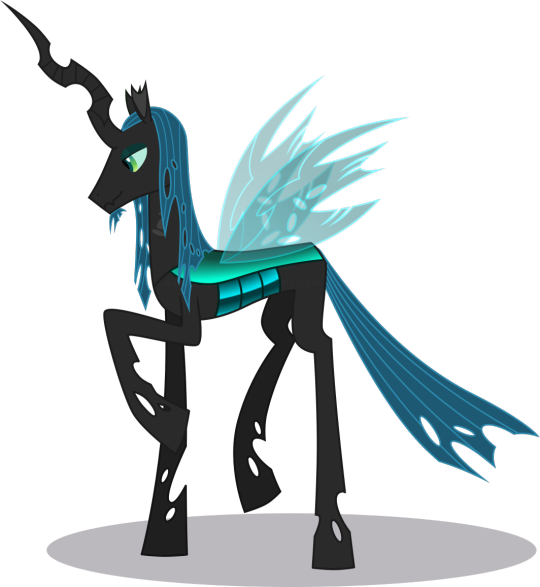
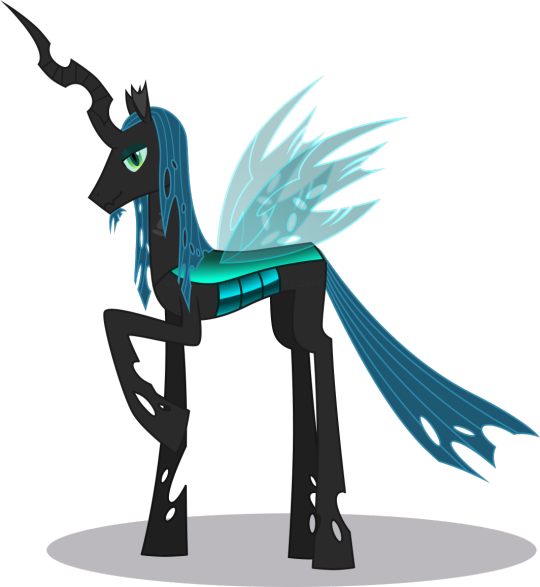

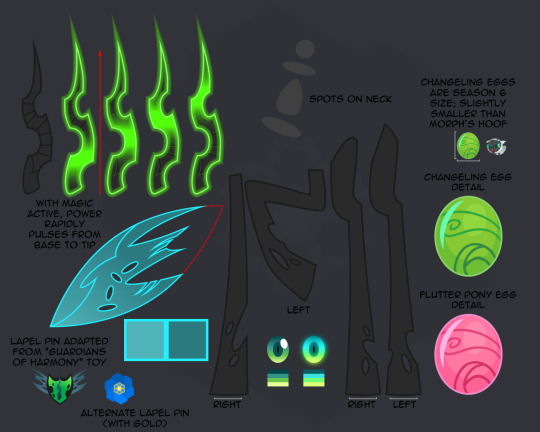
Finally an updated Metamorphosis ref sheet, albeit missing some angles that are still in progress. Really. Truly. I also need to fiddle with the two gradients on his wing, I think I might have angled them incorrectly.
Based on a previous design by @tarajenkins, 2015.
May 9 2024: special thanks to @askcaffeinehazard for help and input to make the “chrome” gradients look better. (As of May 9, 2024, I have done nothing but teleport gradients for three days.)
May 20 2024: revised shell coloration after nearly a decade.
May 21 2024: ...those shell colors are starting to look an awful lot like Chrysalis’ colors. Ah well. It was bound to happen eventually.
#morph#metamorphosis#ref#reference pic#I keep asking myself if his legs are too long in these images#and then realizing that shortening them would be an absolute pain in the neck because of how they're constructed#shifter#oh well#he is a bit taller than Chrysalis anyway#art by me#based on a design by Tara Jenkins#which was admittedly commissioned by me in 2015#and tailored to order#but still because without that design I would not be where I am today#thank you again Tara#he is not a changeling queen#he would have been but older sister has dibs on the throne#so now he owns and operates a book bindery#and is a patron of the arts#and a patron of the local candy store#and the local ice cream parlor#and the local place that makes floral syrups for drink mixing#all the floral syrups all the time#probably a patron of the local book store too#which presumably has a coffee shop that has floral syrups
8 notes
·
View notes
Text
Trillions of domestic phone records in the United States are tracked every year under a secretive surveillance operation, WIRED revealed this week. The Data Analytical Services program, which was previously known as Hemisphere, allows cops to request and analyze the phone records of people and others who they communicate with, including those not suspected of crimes. The surveillance system is run by the White House, with telecom firm AT&T providing phone records in response to law enforcement requests.
The crypto world kept tumbling this week. After Sam Bankman-Fried was found guilty at the start of this month, it was the turn of crypto exchange Binance and its CEO Changpeng Zhao to face scrutiny from US officials. The US Department of Justice unsealed an indictment against the company, which accuses it of violating US anti-money-laundering laws and of enabling Iran, Cuba, and Russia to launder dirty money.
If you’re in the US and have some extra time over the long holiday weekend, it’s also worth catching up on Andy Greenberg’s epic tale of the three young hackers twho brought down the internet with the Mirai botnet—and their story of redemption. Then it’s definitely time to log off.
That’s not all. Each week, we round up the security and privacy stories we didn’t report on in depth ourselves. Click the headlines to read the full stories, and stay safe out there.
Google Ups Its Ad Blocker Crackdown
Google makes most of its money from advertising—and it doesn’t like ad blockers, which prevent millions of ads being shown on websites every day. In recent months, the company has been cracking down on ad blockers on YouTube in a big way. But that’s just the start of it.
This week YouTube confirmed it has, in some instances, introduced a five-second delay before videos load if people are using an ad blocker in their browser. “In the past week, users using ad blockers may have experienced suboptimal viewing, which included delays in loading, regardless of the browser they are using,” a YouTube spokesperson told The Verge. The company admitted the delays had been happening after some people on Reddit and Hacker News spotted slow loading times and initially thought it was because of the browser they were using.
The move follows Google announcing last week that it is going ahead with plans to change how Chrome browser extensions operate, which may limit how some popular ad blockers work. Last year the company paused its plans to roll out Manifest V3, the platform that browser extensions work on, after complaints about how it would impact some extensions. As Ars Technica reported, Google is planning on rolling out a revised version of Manifest V3 in June next year. Google says Manifest V3 is designed to make Chrome run smoothly by reducing the resources that extensions can use and improve security. However ad blockers and privacy experts have criticized how the system works and, in particular, changes to the Declarative Net Request API.
Google proposed putting restrictions on this API but has relaxed these somewhat in the new version of Manifest V3. It originally planned to allow browser extensions to make 5,000 content-filtering “rules,” but it has now increased this to 30,000 rules. AdGuard, an ad blocker, has tentatively welcomed some of the revised changes. Elsewhere, uBlock Origin, which uses around 300,000 filtering rules, has created a “lite” version of its extension in response to Manifest V3. The developer behind uBlock Origin says the lite version is not as “capable” as the full version. Meanwhile, browser makers Brave and Firefox say they are introducing work-arounds to stop ad blockers from being impacted by the changes.
North Korea Is Increasingly Launching Supply Chain Attacks
Supply chain attacks, where malware is implanted in a company's legitimate software and spread to the firm's customers, can be incredibly hard to detect and can cause billions of dollars in damage if they’re successful. Hackers for North Korea are increasingly adopting the sophisticated attack method.
This week Microsoft revealed it has discovered the hermit kingdom’s hackers implanting malicious code inside an installer file for photo and video editing software CyberLink. The installer file used legitimate code from CyberLink and was hosted on the company's servers, obscuring the malicious file it contained. Once installed, Microsoft said, the malicious file would deploy a second payload. More than 100 devices have been impacted by the attack, Microsoft says, and it has attributed the attack to the North Korea-based Diamond Sleet hacking group.
After details of the attack were revealed, the UK’s National Cyber Security Centre and the Republic of Korea’s National Intelligence Service issued a warning saying that North Korea’s supply chain attacks are “growing in sophistication and volume.” The two bodies say the tactics support North Korea’s wider priorities, such as stealing money to help fund its ailing economy and nuclear programs, espionage, and stealing tech secrets.
Planes Are Being Disrupted by GPS Spoofing and Electronic Warfare
Some flights have had to change course or lost satellite signals in midair due to electronic warfare, The New York Times reported this week. The ongoing conflicts in Ukraine and Gaza have seen GPS jamming and spoofing technologies interfere with the daily operation of flights in and around the areas. The incidents, so far, have not been dangerous. But they highlight the increase in electronic warfare capabilities—which seek to interrupt or disrupt the technologies used for communications and infrastructure—and how the technology needed to launch them is getting cheaper. Since Russia’s full-scale invasion of Ukraine in February 2022, electronic warfare tactics have become increasingly common on both sides, as drones being used for surveillance and reconnaissance have had their signals interrupted and rockets have been sent off course.
Russian USB Worm Spreads Beyond Ukraine’s Borders
Gamaredon is one of Russia’s most brazen hacking groups—the hackers have consistently attacked Ukrainian systems. Now one piece of its malware, a worm that spreads via USB stick and is dubbed LitterDrifter, has spread internationally. The worm has been spotted in the US, Hong Kong, Germany, Poland, and Vietnam, according to researchers at security firm Check Point. The company’s researchers say the worm includes two elements: a spreading module and a second module that also communicates with Gamaredon’s servers. “It’s clear that LitterDrifter was designed to support a large-scale collection operation,” the Check Point researchers write, adding that it’s likely the worm has “spread beyond its intended targets.”
3 notes
·
View notes
Text
youtube
Demo Review: Neil Young - “Boxcar”
There was no banjo when Neil Young demoed “Boxcar” for the sessions that produced Ragged Glory.
Out now and following behind “Don’t Spook the Horse” in previewing Official Release Series Volume 5’s July 14 arrival, the previously unreleased, 1990 recording proves Young was wise to hold and re-record it for 2007’s Chrome Dreams II.
Relatively weak on the lyrics front, the melody and rhythm evoke the mode of transportation referenced in the title. But the banjo propels it better than the echoey electric guitar and accordion on the initial recording, as Young sings with an uncharacteristic rasp:
I’m like a black man/I’m like a white man/maybe a red man, I don’t know
Young unfortunately didn’t revise the lyrics. But, as this demo shows, he made the right call on the music front.
Grade card: Neil Young - “Boxcar” - B-
6/20/23
4 notes
·
View notes
Text

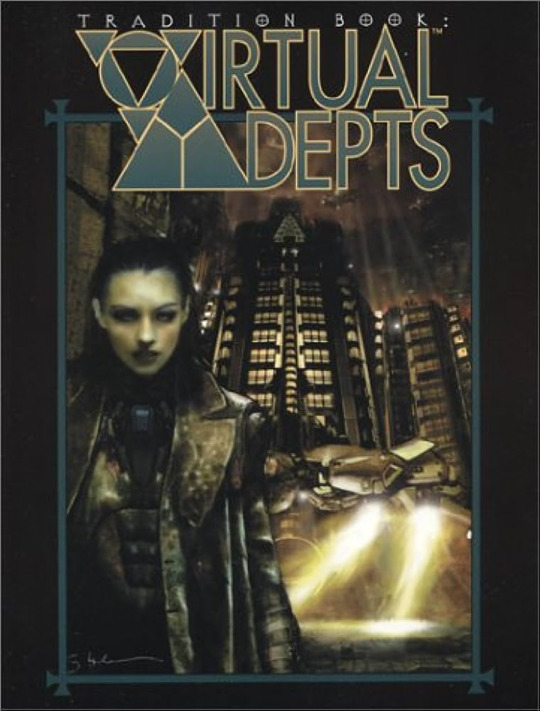
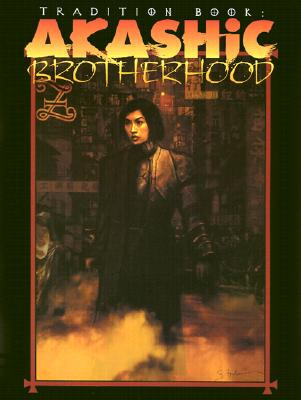


#RPGCovers Week Thirteen
Transhuman Space (2002)+
Christopher Shy
I’m surprised that given the length of this series so far, I’m only now talking about Christopher Shy. His work stands for a chunk of the 1990s and 2000s for me. It’s iconic, unique, and always recognizably his. I had a lot to choose from but I keep coming back to Transhuman Space. I’ll talk about that and then the way his Mage work actively redefined the game itself.
Transhuman Space is a “Powered by GURPS” book with a decent number of supplements. Shy did the covers and provided the interior art to several in the series. Like many of Shy’s best pieces, it is a kind of pseudo-collage. You can see several disparate elements blended together by a water-color darkness. I’m not sure how else to describe it. The effect is to be out-of-focus, but in a way that gives us room to imagine what’s going on.
I especially love how with TS the hard sci-fi aesthetic of the setting is undercut by the almost impressionistic imagery. This isn’t sharp lines and gleaming chrome. It is rough, bespoke, overwhelming, and human. It points to a very different kind of sci-fi games and signals another aesthetic. Like, and this is really just my reading, we have the idea of Transhumanism (like we see in the slick clean look of something like Eclipse Phase). But our central figure in the middle of the page is in a grimy, retro space suit that wouldn’t look out of place in a 1960s film. Again contradictions that say something about the setting itself.
Shy’s best work establishes that feel and tone super clearly. As I mentioned above, one of the best examples of that is the change in White Wolf’s approach to Mage the Ascension. I love early Mage, which is defined by some of the amazing work of Michael Kaluta (who I’ll come back to tomorrow). His designs have a clean, brilliantly drafted look to them. The covers for the Mage 1e Tradition books, sharp black lines on metallic covers, speak to the forward looking elements of that iteration of the game: magic, wonder, and potential.
Then eight years later, WW revised those books, expanding them and bringing them up to date with the changes in rules, setting, and especially tone of Mage. Gone were the clean, distinct lines. Shy’s images are muddy, melancholy, and fallen. The Traditions have lost and are picking up the pieces. Yes, the books all fit in a series, but the links are from the whole book design, rather than the echoes Kaluta gives. Instead each Shy piece is different, like washed out photos of broken people. Some have a more powerful look, but the darkness around them undercuts that.
It’s one of the best uses of covers to present a new take on a game line: creating a break with the past and telling us a new story about the setting.
2 notes
·
View notes